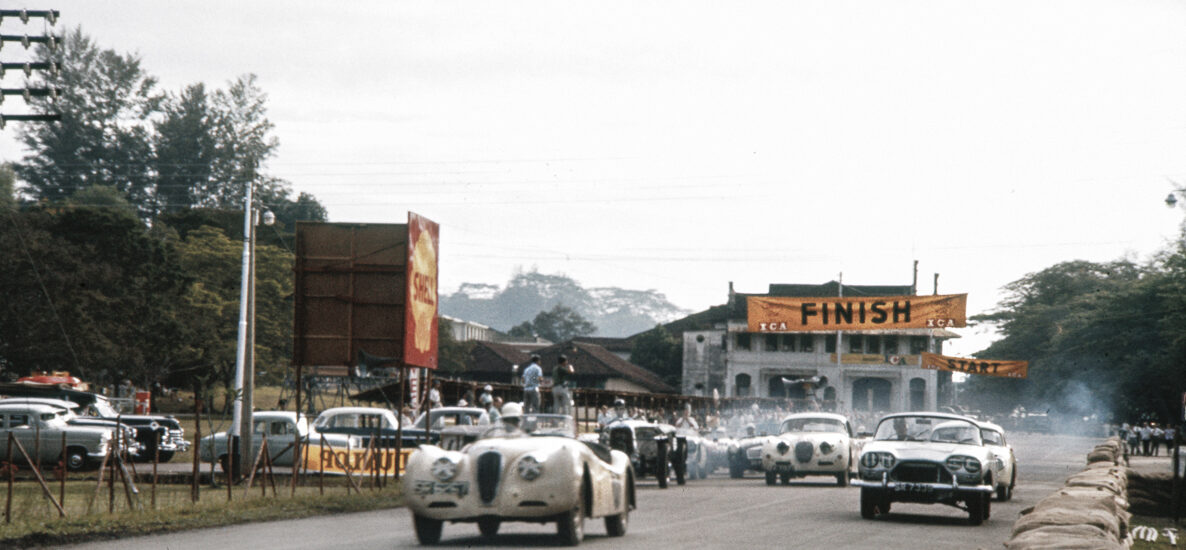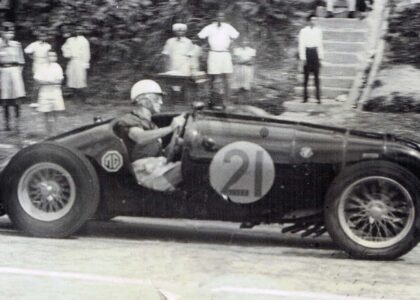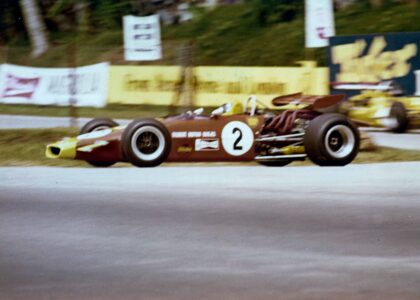Let’s take a look at the 1960, 1961, and 1963 Johore Grand Prix races, including supporting races for cars and motorcycles. Full race results on request.
By Eli Solomon
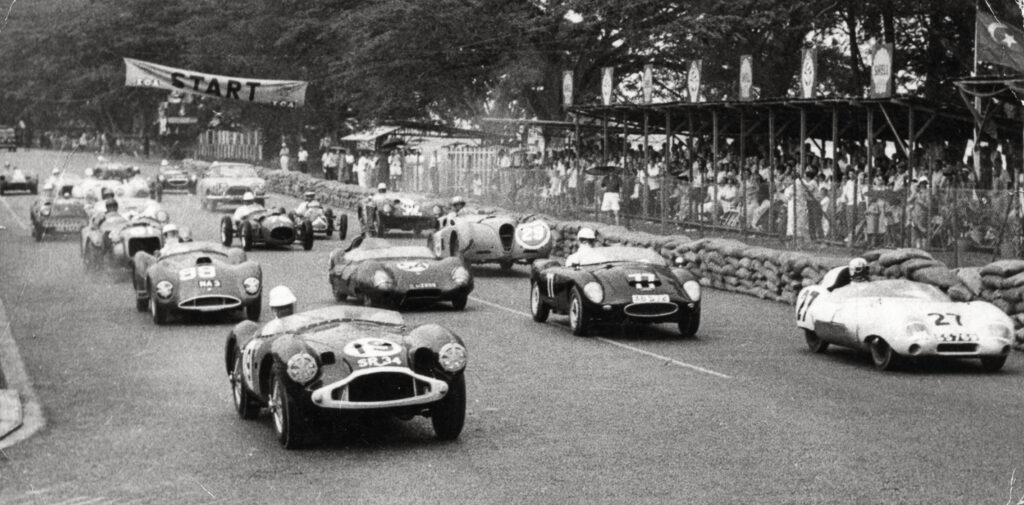
And they’re off! Start of the 1960 Johore Coronation Grand Prix…before the weather turned foul and levelled the playing field. The grid consisted of 3 cars in the front row, 2 in the second, 3 on the third etc.
That single fatality during motorcycle practice at the 1953 Johore Grand Prix on Saturday 1st August 1953 was a blow to the sport in South East Asia; Osman Abbas was the workshop manager for Kyle, Palmer & Co., agents for Norton motorcycles, a familiar figure at the races and many of the riders knew him.
Kyle, Palmer had sponsored both top riders Jock Muir and Bill Cleugh in earlier Grands Prix, and Rodney Seow, a student who competed in the 1952 Johore Grand Prix, who had taken delivery of his Norton International from Abbas when he acquired his bike for the 1952 event. The shock to all was palpable. [See JOHORE GRAND PRIX – Part 1: 1949-1953]
Although none of the races were cancelled that fateful weekend, the on going Communist threat (termed the Malayan Emergency) and the death of Osman Abbas would certainly have given H.R.H. Tengku Makhota of Johore and the Singapore Motor Club (SMC) cause to ponder over the perils of motor racing during that period.
LONG INTERLUDE
Seven years passed before Johore held its next Grand Prix, by which time Macau had firmly established itself as the only venue in Asia with an annual Grand Prix. The locals had a fleeting taste of circuit racing when the SMC collaborated with the Forces Motoring Club to host a circuit meeting at RAF Changi in 19571. It turned out to be a one-off fling with circuit racing, but it was sufficient to galvanise local enthusiasts into thinking about hosting an annual Grand Prix on the island, notwithstanding the fact that at club level, there were, on average, a sprint, hill climb or social event every month.
Grand Prix aside, motor sport had taken off in Asia from the mid-1950s. Hong Kong, Malaysia, Philippines and Singapore had their fair share of drag races, sprints and hill climbs. Further afield, Sri Lanka and India both had hill climbs with Indian enthusiasts holding sports car races at airfields.
While politics and nationhood had seen leaping strides in Malaya, despite efforts of the respective motor sports clubs, the sport in the country had barely progressed beyond club events. But there was impending change in the air.
There were rumours that a Grand Prix to commemorate the independence of the Federation of Malaya from British colonial rule in 1957 would be held in Singapore and be called the Merdeka Grand Prix. While nothing came of the rumour, the decade ended with much enthusiasm and many new race cars arriving in Malaya and expectations of yet another Grand Prix, this time in Johore.
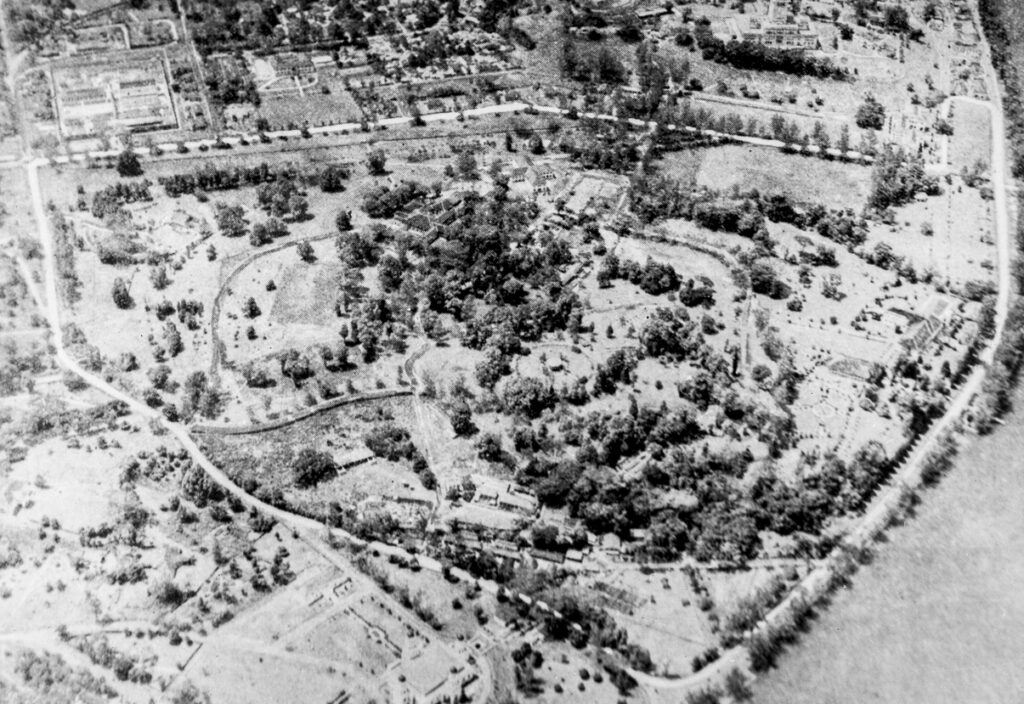
Aerial view of Johore Bahru showing the layout of the street circuit used for the Grand Prix. 12 miles of fencing wire was required to surround the Johore Grand Prix circuit for the 1960 Grand Prix!
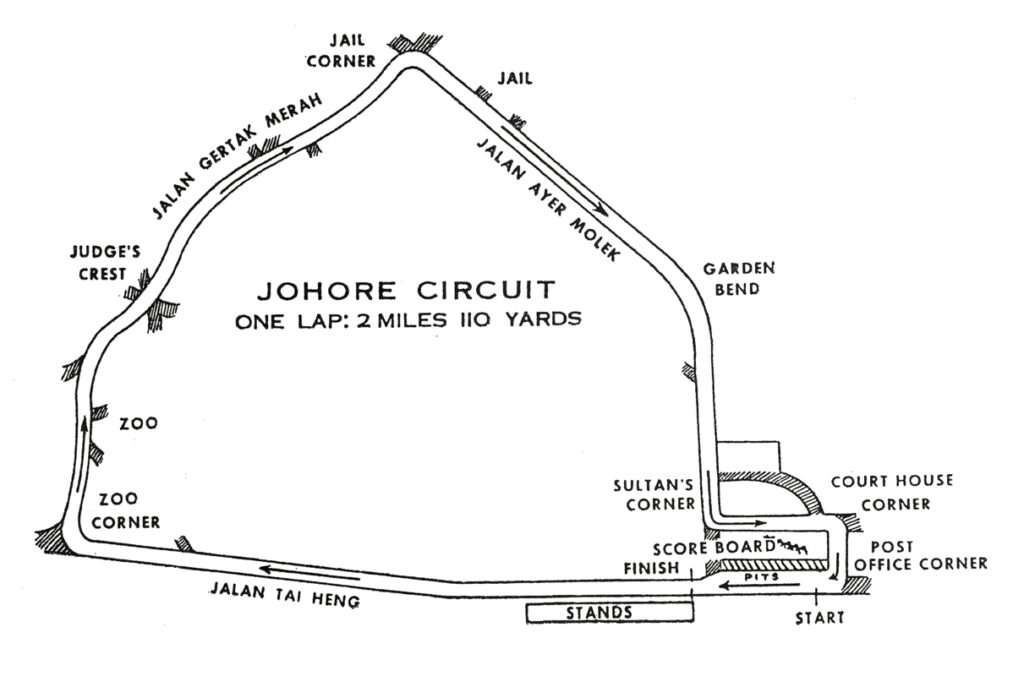
The layout of the circuit. The start is opposite the small paddock in front of the gates of the Istana. Cars then head along the sea front towards Zoo Corner, round the bend by the Mosque and up the hill past the zoo. Next approach is Judges Crest – some cars actually leave the ground at speed. Next is down to Jail and Jail Corner – downhill slope that strains the brakes at 95 mph before a right turn – round Jail Corner in second gear and accelerate to the next bend, a deceptively gentle right hander which leads back to the padang. Then around the padang in second gear and on to the sea front again. For the 70-lap Johore Grand Prix a car could easily have around 770 gear changes.
THE SWINGING BEGINS
The buzz became apparent at club level from the start of the 1959 season. The ever-popular Lim Chu Kang ½-mile Sprint in Singapore, always a good barometer of interest for racing up and down the Peninsula, featured a bursting list of race cars entered in the March event.
As Singapore Motor Club magazine editor Loris Goring put it, “Lim Chu Kang…brought out the most impressive array of machinery seen in Singapore for many moons.” Tony Huggett had a “new” Lotus Eleven Climax in Le Mans specification. Phil Caroline had a monster hybrid, a Studebaker Golden Hawk-engined Allard J2X. The pair represented the extremes of design and engineering.
Chan Lye Choon, now established as an international champion following his win in the 1958 Macau Grand Prix in an Aston Martin DB3S2, was toying around with George Baker’s old Ferrari Monza3. Bernard Arnold had the Cooper Jaguar (nee Warrior Bristol) 4. Carlo Vigano, who had ditched the Alfa Romeo 8C-2300 in Johore in 19535, had a Fiat Abarth 750.
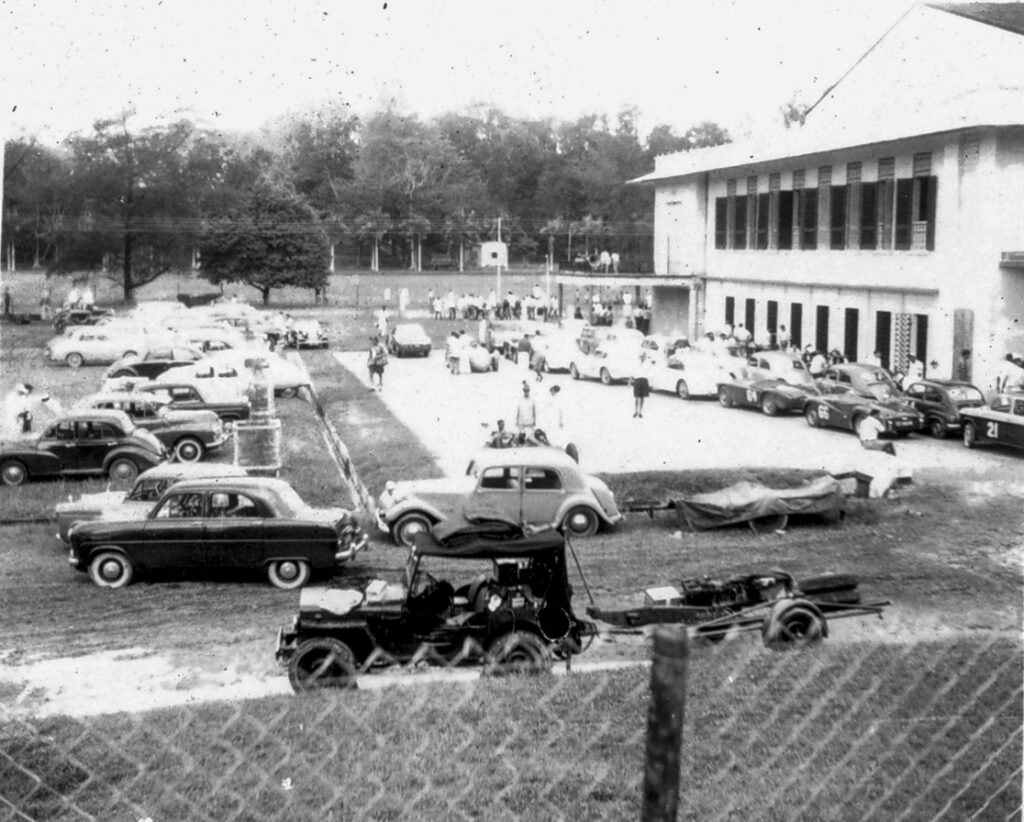
The paddock at Johore’s Sultan Ibrahim Diamond Jubilee Town Hall6 on Saturday 20 February 1960. All the cars congregated on Friday afternoon at the Jubilee Hall for scrutineering – a long process that began at 2.30pm and ended at 2am on Saturday!
The racing cars were also there in force: the Chans of Eastern Auto, Citroën distributors, had ditched their MG TDs for Cooper JAPs; Neil Moncrieff and Jimmy Milne shared another Cooper JAP; and Lim Peng Han had his Lim Special, formerly a Kieft Mk1-A. Others included Stanley Leong in his “Works” MGA, the car that eventually became the SL Ferrari (the body was discarded in favour of a Tan Ah Bee-built Special with a Ferrari engine shoehorned into it) 7; Barry Swann had an AC Ace; Yong Nam Kee ran his “Fatso’s Delight” Austin Healey 100S with restyled nose; and Ian Barnwell had a Jaguar XK120. Every single one of these cars was a potential Grand Prix winner, and would play a big part in the history of racing in Malaysia.
BIG BANG
The following year’s motor sport calendar in Malaya was announced in September 1959. After seven years of ceaseless campaigning by the SMC and its erstwhile President Freddie Pope with the Johore royal family, there was finally going to be another Johore Grand Prix, this one to celebrate the coronation of H.R.H. Sultan Sir Ismail as the third Sultan of modern Johore.
H.R.H. Sultan Sir Ismail had been the Tengku Mahkota (Crown Prince) and succeeded his father Sultan Ibrahim when the latter passed away in May 1959. Regardless, H.R.H. Sultan Sir Ismail had been the de facto ruler of Johor from 1928, acting as the state’s Regent when his father, the Sultan, began to spend his time in Europe.
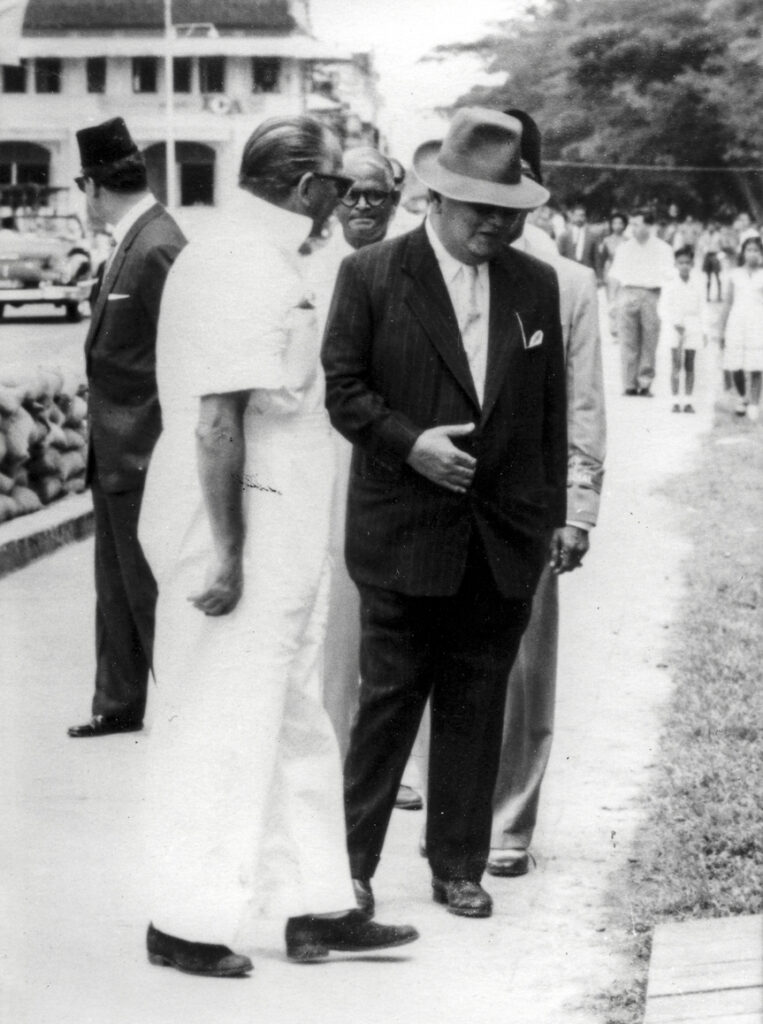
“The 1960 Johore Coronation Grand Prix has gone down in the history of Far East motor racing as one of the greatest motoring events that has ever been attempted.” Freddie Pope, President of the Singapore Motor Club, 1961
To top off 1959, the Macau Grand Prix concluded almost as a SMC benefit, the Singapore-entered cars finished 2nd, 3rd, 4th and 5th, a most fitting end to the year, and an excellent way to usher in the new golden age of racing in Asia.
Interestingly, Bob Burke, who was based in Malaya, was a regular contributor to Australian magazines, in particular Australian Motor Sports, did a big feature on the Sultan of Johore’s stable of cars in the December 1959 edition of this monthly magazine. Bob was the A.M.S.’s Eastern Correspondent. His two pager on the Sultan’s car collection makes for very interesting reading. I paraphrase here what Bob wrote about the 1960 Johore Grand Prix: “They are a very motor minded people, and another example of this is the Johore Grand Prix, under the patronage of His Highness. Until 1953, this was the premier motoring event of south-east Asia, and drew large crowds from Singapore and the Federation. The race has not been held since then, but is almost certain to be revived in 1960. With the array of potent machinery now present in the area, it is sure to be impressive.” [Source: Australian Motor Sports, December 1959]
DROP THE FLAG
The Malayan Emergency officially ended in 1960, the majority of the remaining Communist guerrillas having fled to the Thai border. The State of Emergency would only be officially lifted on 31st July 1960, but this was a moot point.
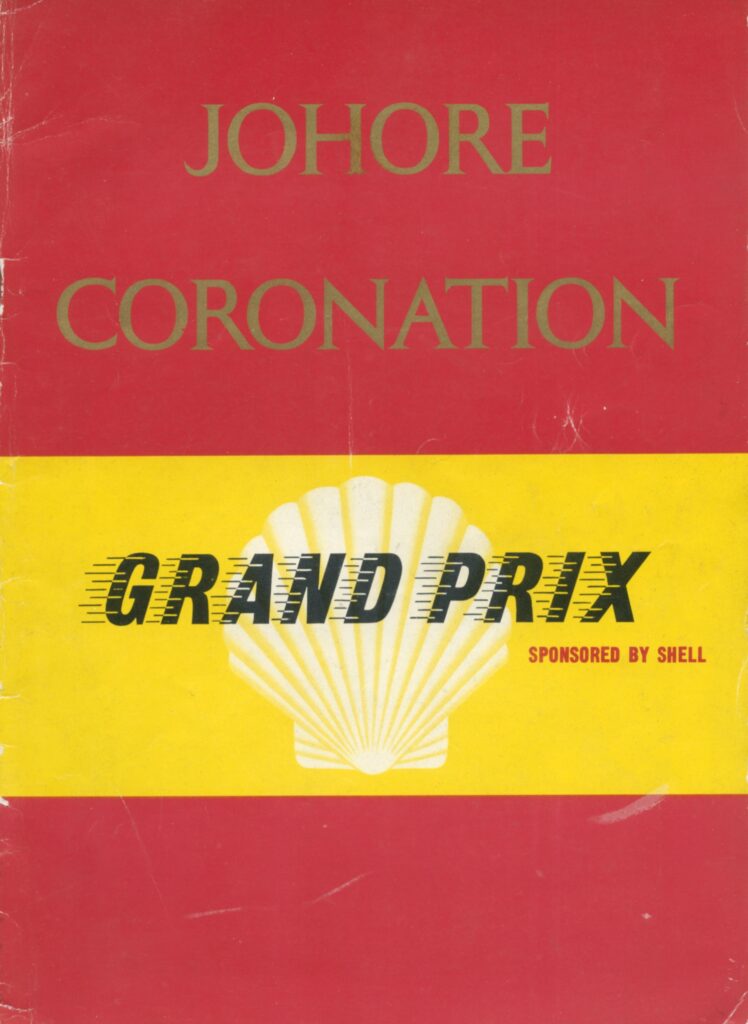
The Coronation Grand Prix, set for February 1960, catered for motorcycles, saloons and tourers, sports cars, vintage cars, and, the icing on the cake, Formula Libre machinery. The circuit, round the streets of Johore Bahru, remained the same as in 1953, covering 2 miles 110 yards (3.32km), exactly as it had when it was last run in August 1953. With the celebrations already underway for the coronation, there was no effort required to generate interest in the Grand Prix, “all the organizers had to do was to drop the flag,” as the motor club’s editor pointed out.
…all the organizers had to do was to drop the flag.
Gone were the days of a quick drive from Singapore across the straits of Johore where only a casual customs hut welcomed visitors. There were also now special rail services for visitors to the race, priced at S$1.60 for a return ticket. For just 50 cents (1/2d.), enthusiasts could watch the 153 entrants tackle 14 races over the weekend. It was no surprise that spectators showed up in the thousands to catch some proper motor racing action that weekend.
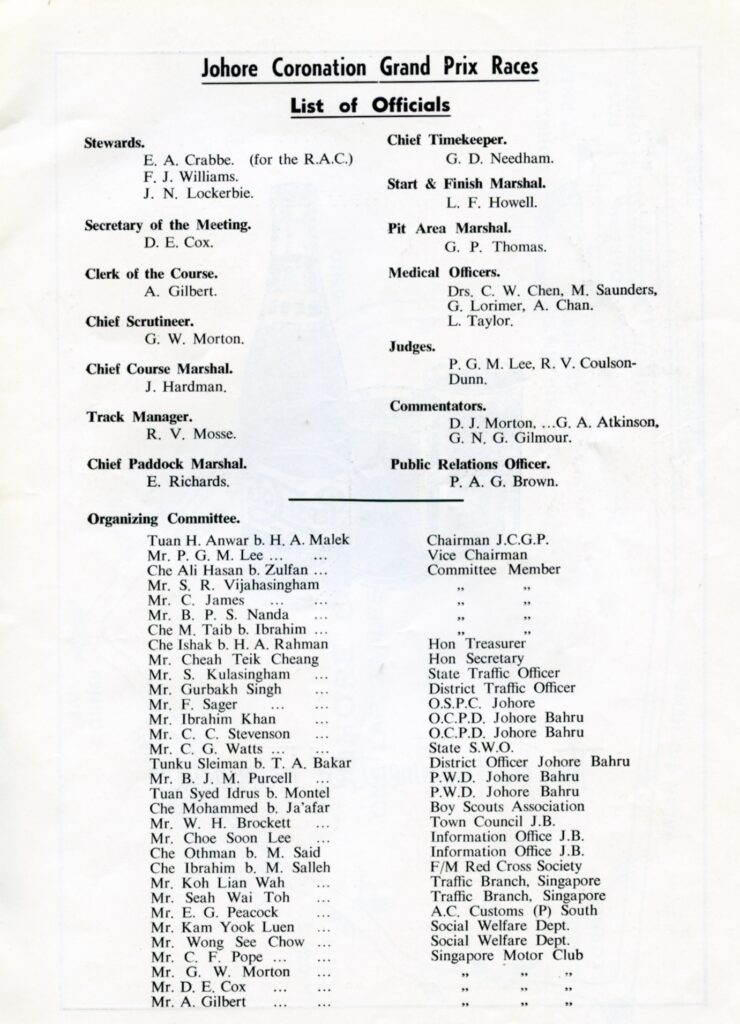
Officials of the 1960 Johore Grand Prix.
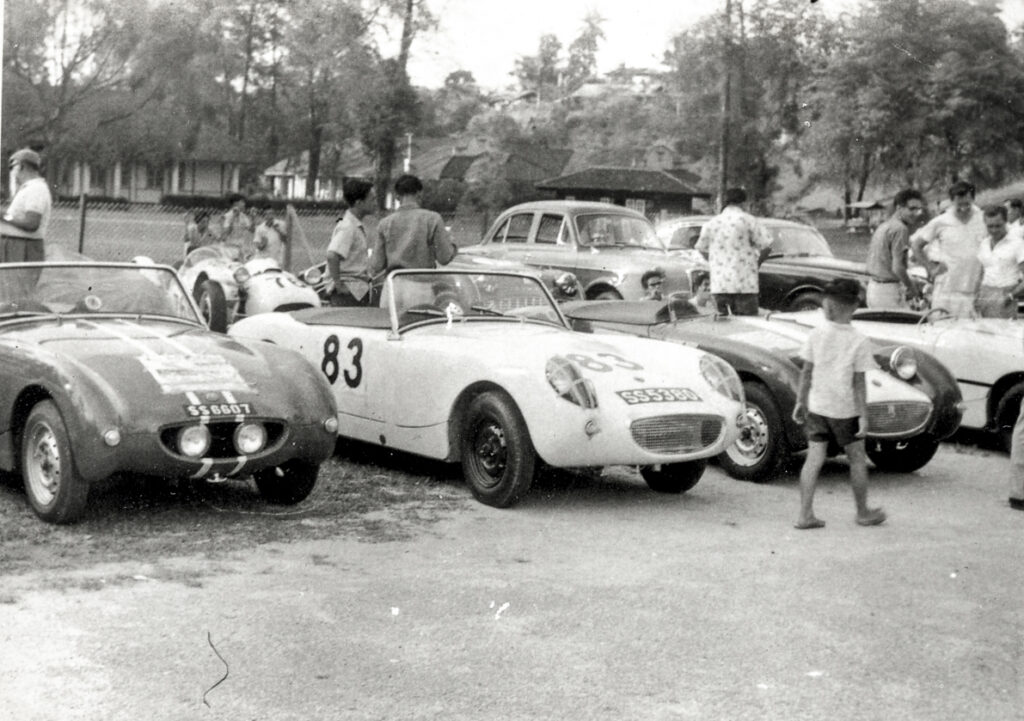
A trio of modified Austin Healey Frogeye Sprites line up at Jubilee Hall ahead of Race 2 for Sports Cars 1,000cc and below and 1,101-1,500cc (15 laps). Seven Frogeye Sprites participated in this race.
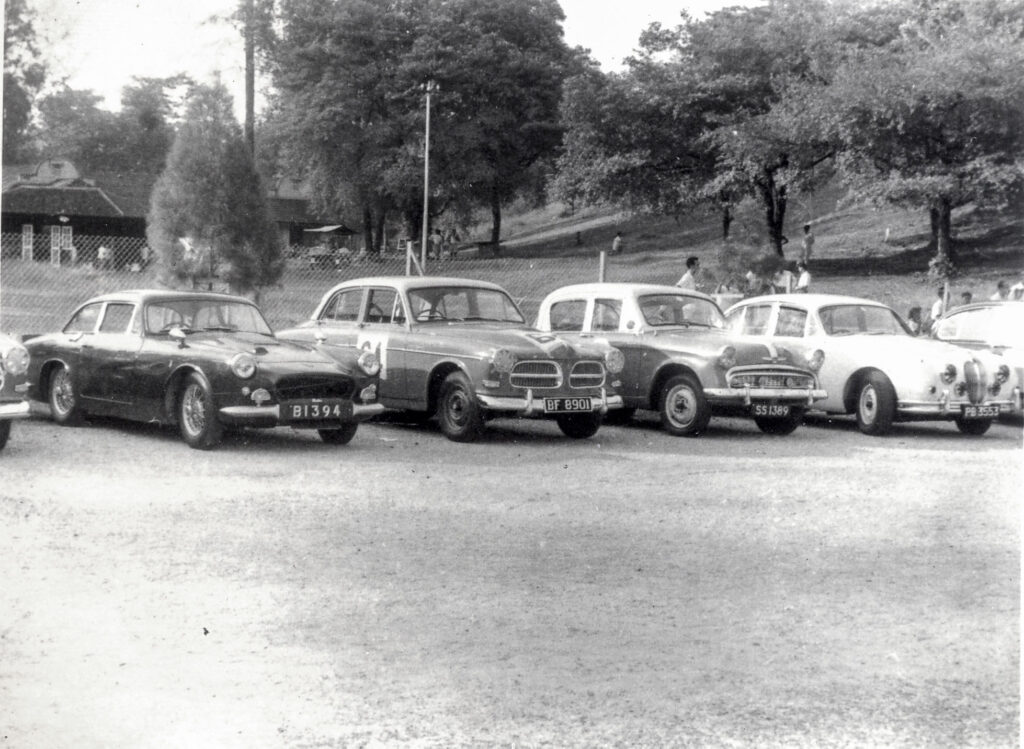
The larger class of Saloons and Tourers parked by Jubilee Hall on the Friday ahead of their 15 lap race during the weekend. The car to the left is a Peerless GT run by Bob Usher. The Volvo to its left is Spink’s B16 (which finished second overall and second in class in that race). Lee Ah Fui’s Hillman Minx 1,494cc is to the left of the Volvo with an unidentified Mk2 Jaguar to the left of the Hillman.
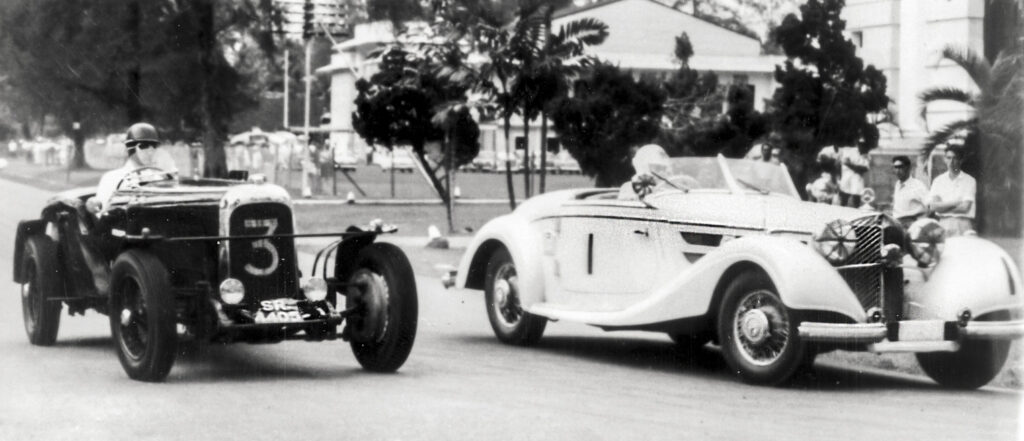
H.R.H. The Tunku Makhota’s supercharged 1937 540K Mercedes passing David Morton’s Lagonda into second place on Sultan’s Corner in the 1960 Coronation Grand Prix. The 540K was built at the end of 1936 and delivered to the Mercedes Benz distributors in London for the Sultan of Johore in August 1936. The Sultan took over ownership in October 1936.
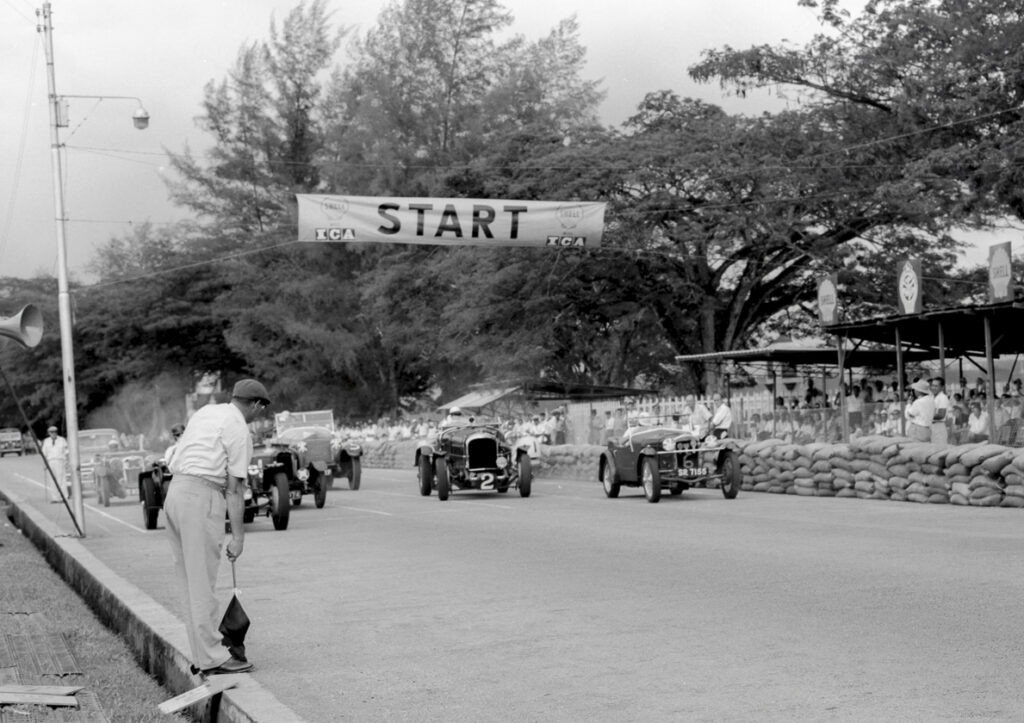
Vintage cars at the Johore Grand Prix.
WATER WATER EVERYWHERE IN JOHORE
Storm clouds had begun to appear and it was not long before the circuit was drenched with a warm shower and the main Grand Prix was declared a wet race. Memories of the nearly-washed-out 1940 Johore War Effort Grand Prix must have flooded by for Lim Peng Han and Jimmy Milne.
…Bill Wyllie pulled out all the stops and the little front-wheel-drive Willy Zoltberger-tuned two-stroke Auto Union popped, banged and farted off the line like a scalded cat…
There were 20 starters on the grid for the Grand Prix and the atmosphere was electric. When Freddie Pope dropped the flag to signal the start of the 140-mile race, Bill Wyllie pulled out all the stops and the little front-wheel-drive Willy Zoltberger-tuned two-stroke Auto Union DKW 1000 RS8 popped, banged and farted off the line like a scalded cat, out-driving much larger and faster cars, and even a pair of Lotus Elevens.
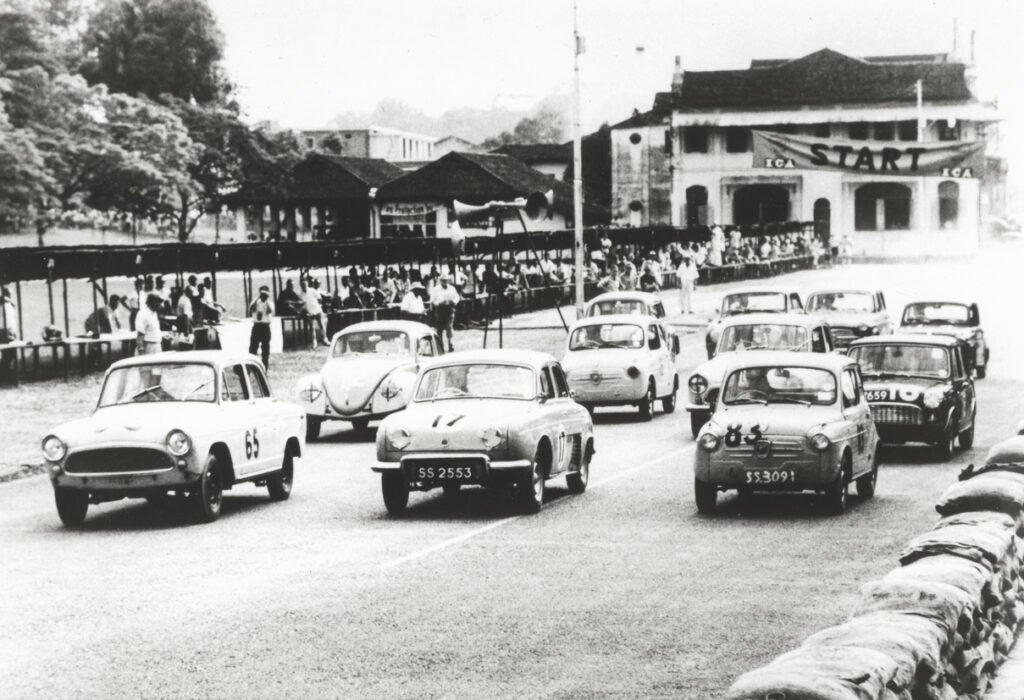
Start of Race 6 for Saloons and Tourers and Giant Killers. The grid positions were drawn by lots as there was no timed practice to determine positions. Chief Timekeeper, Danny Needham, had succeeded in getting his team of timekeepers to click their stopwatches like Le Mans veterans. The front row of the grid shows Carlo Vigano’s Fiat Abarth (# 83), Roy Priest’s Renault Dauphine Gordini 845cc (#17) and Stephen Seow’s (#65) Simca Elysee. Dickie Arblaster’s Austin Mini (#18) sits behind the Fiat Abarth. Arblaster won the event.
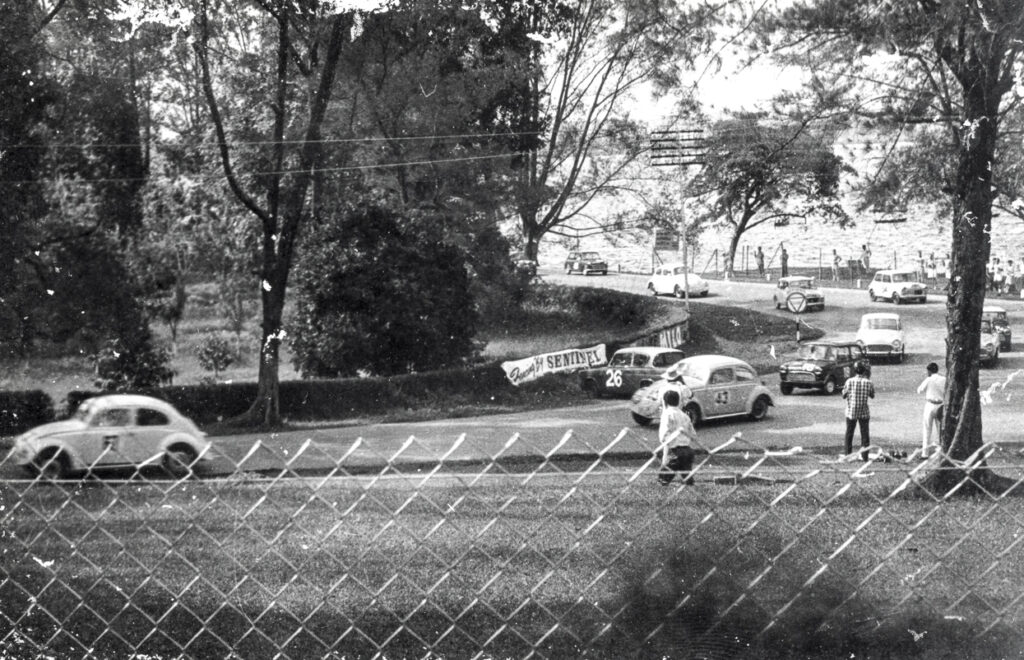
A gaggle of cars entering Zoo Corner in Race 8 for Saloon and Tourers. It was a battle between Simca and VW. Chia Eng Quee won in his Denzel-tuned VW with Dickie Arblaster second in his Austin Seven and Rodney Seow third in his stock standard VW with one new tyre. Stephen Seow set FTD in his 1,290cc Simca. The photo shows Rodney Seow leading Chia Eng Quee and Dickie Arblaster with McCaffrey’s stricken Ford Anglia precariously parked by the side of the track.
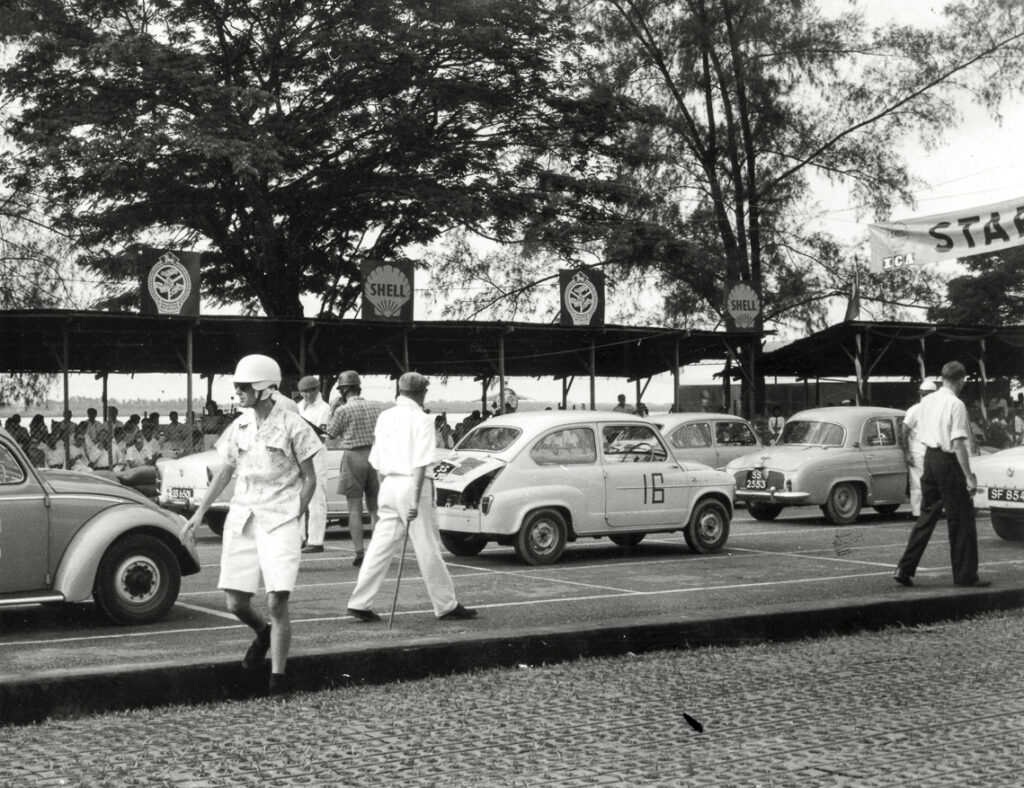
Pat Thomas (with the walking stick) at the start of the saloon and tourer race. C.P Thomas was the chief pit/paddock marshal for the event. In the foreground is Mr. Giant Killer himself, Dickie Arblaster. The #16 Fiat Abarth in the picture is the car of the Forces Motoring Club of Singapore’s Editor, Tym Dickins.
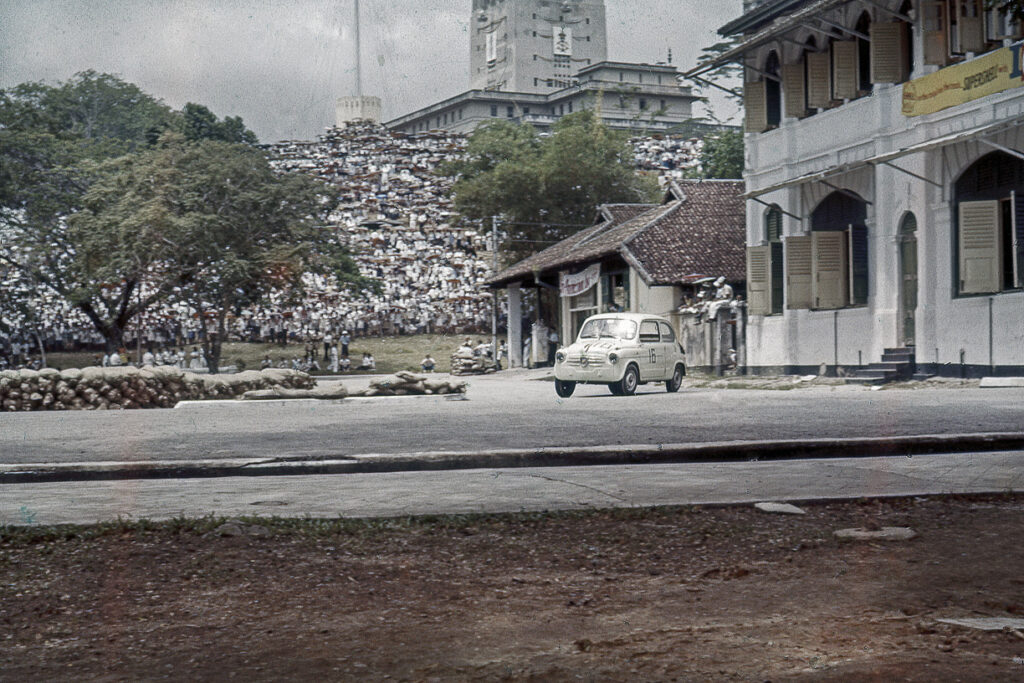
Forces Motoring Club Editor Tym Dickins managed a second place finish in the Saloons & Tourer race early Sunday morning during the Coronation Grand Prix.
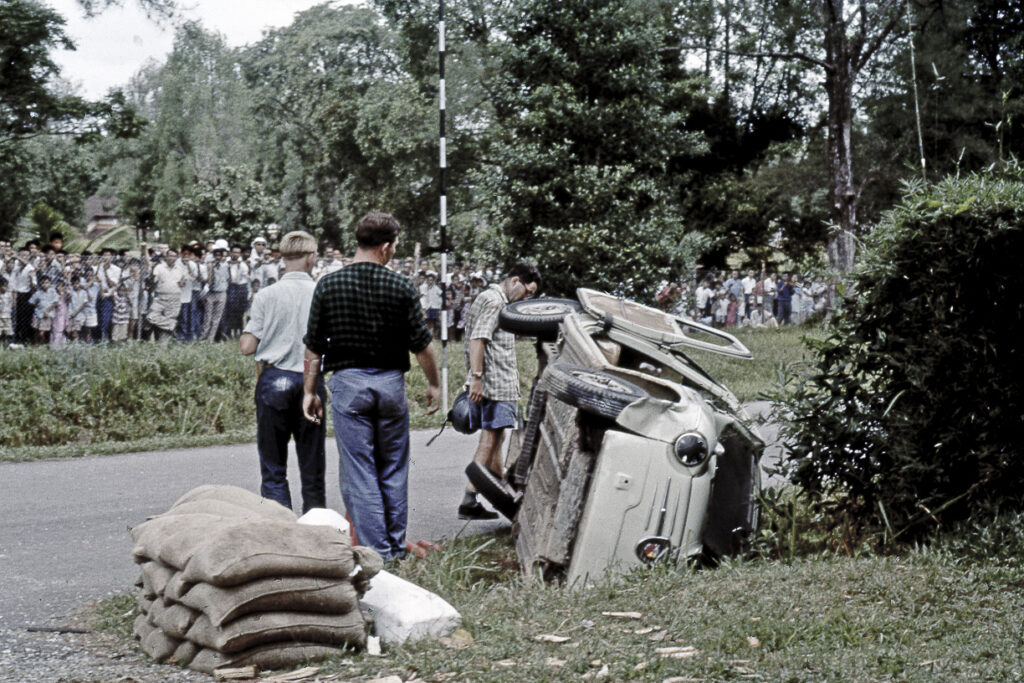
Unfortunately for Tym Dickens, his 747cc Fiat Abarth came unstuck in the afternoon support race when he overturned near the unprotected Press Box at Post Office Corner, “a third party instrumental in the outcome.”
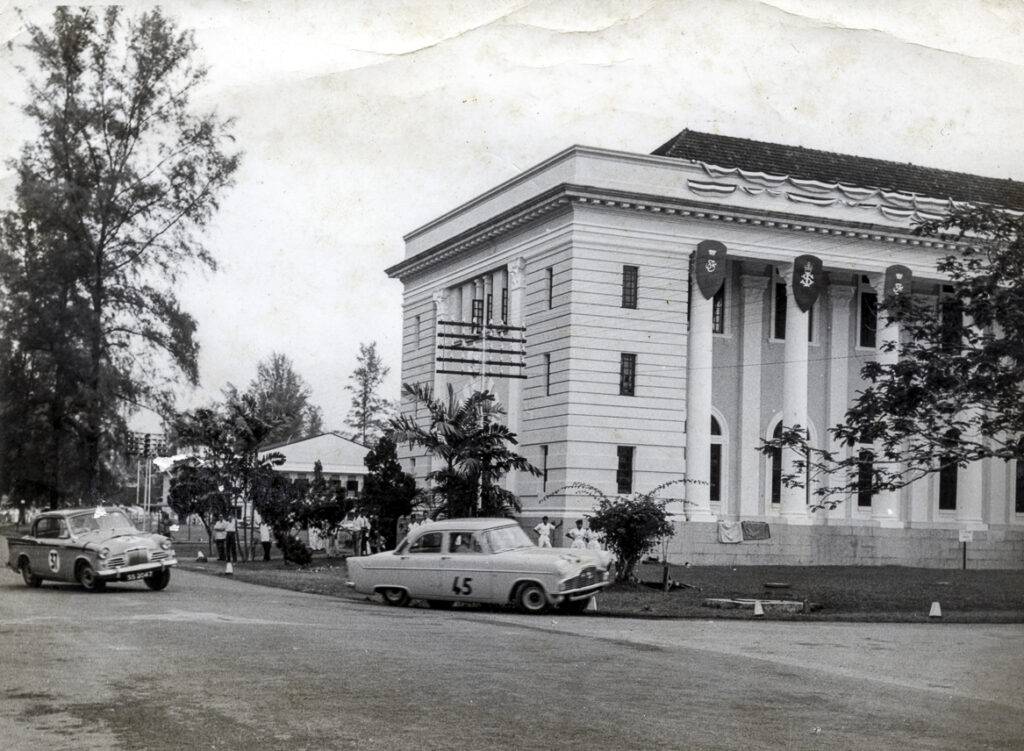
Bill Wyllie (Sunbeam Rapier) chases down P.R. Glover (Ford Zephyr) in the Saloons and Tourers 5-lap race in 1960. The Sunbeam was a Lyons Motors car used by Dickie Arblaster’s secretary!
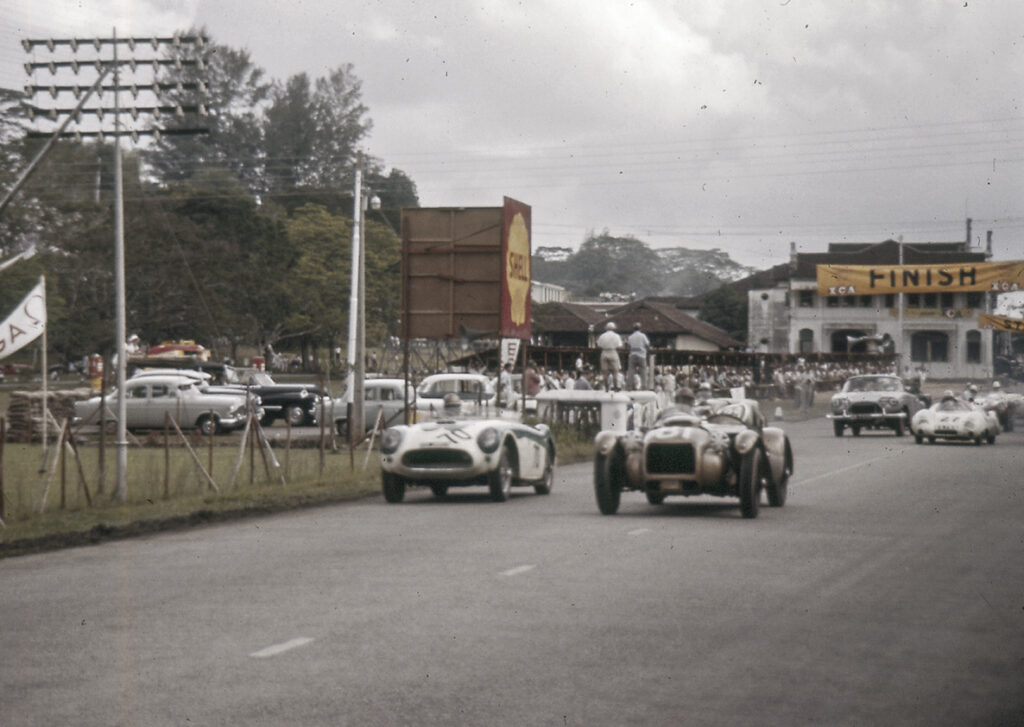
Phil Caroline’s well-worn Allard J2X (No.81) blasts down the main straight with Yong Nam Kee trying to keep up in his Austin Healey 100/4 during the start of the 1960 Johore Coronation Grand Prix. The faster cars had already made their getaway.
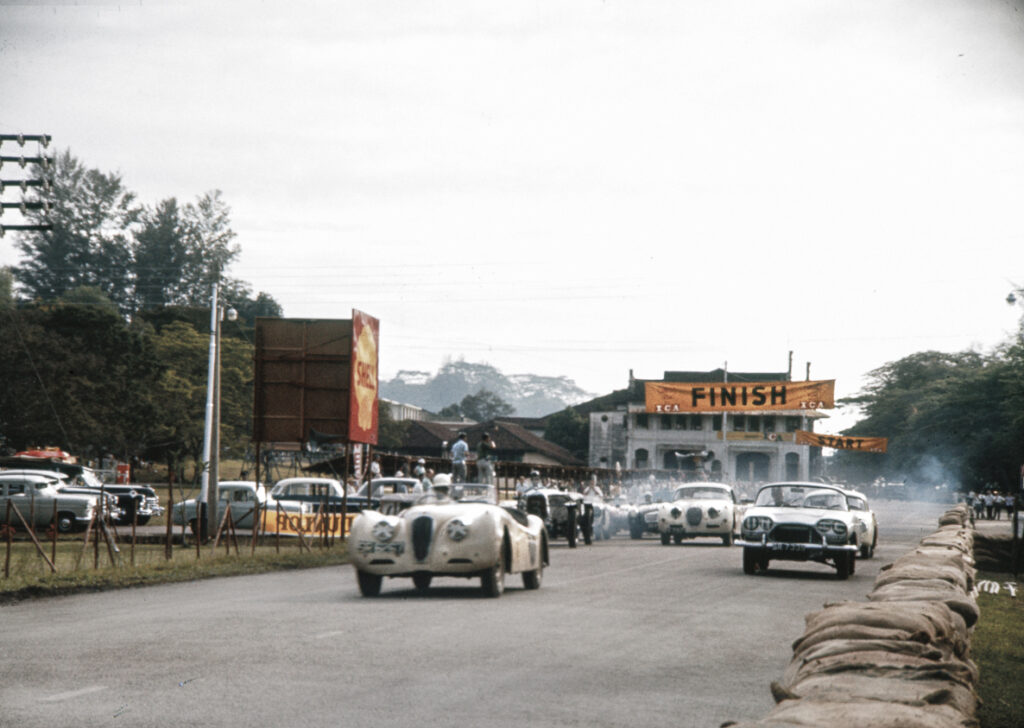
The front-runners take off in the Sports Cars support race of the 1960 Johore Coronation Grand Prix. Temerloh planter Ian Barnwell leads in his Jaguar XK120.
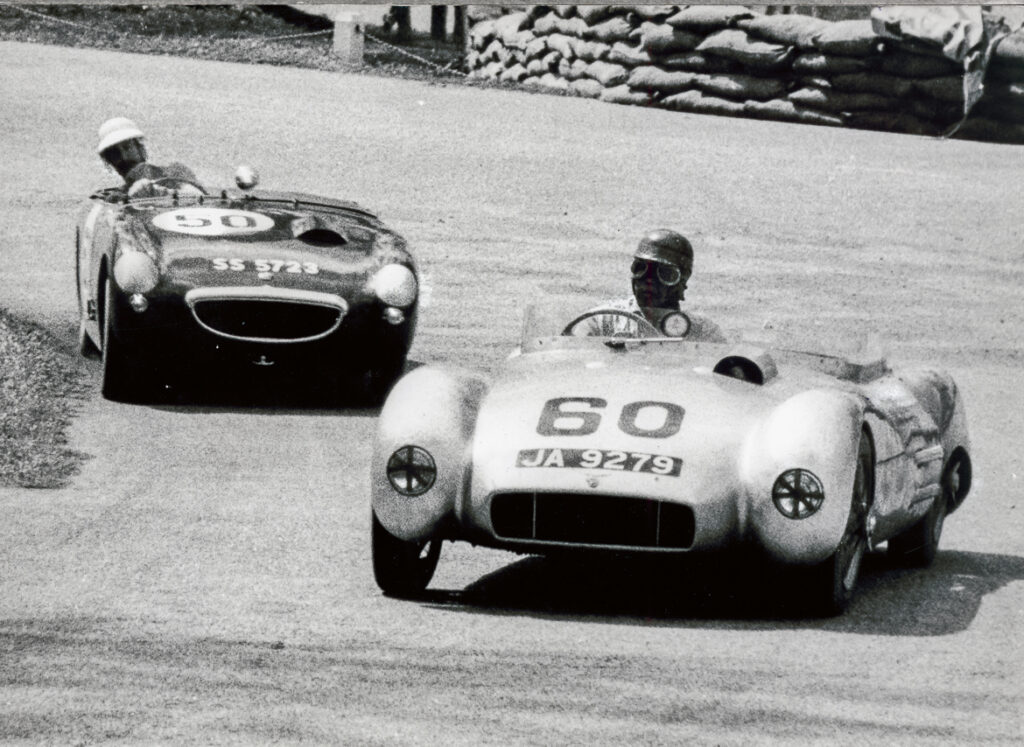
You could not have had better-looking specials in a race than you would find in the 1960 Johore Grand Prix. The BB Special of Yap Ah Shong takes a fairly wide line round Gaol Corner with Peter Brown, Singapore Motor Club secretary chasing in an Austin Healey Sprite.
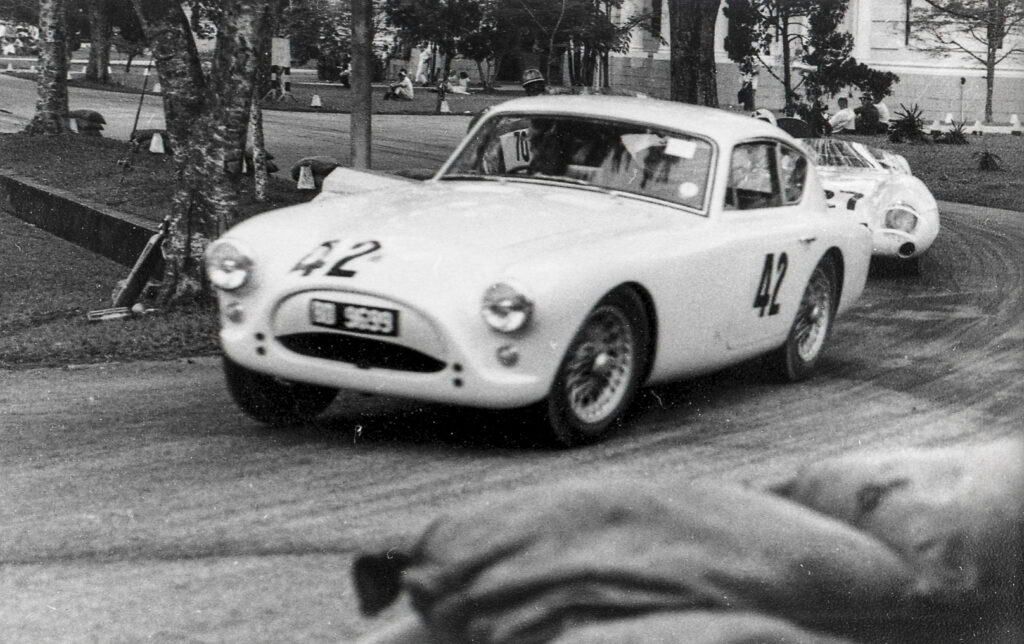
Bill Cowie muscles his AC Aceca with Tan Ah Bee in close pursuit in Tony Huggett’s Lotus Eleven Le Mans Climax during the 20-lap Race 12 for Sports Cars. Cowie finished 14th with Ah Bee 17th. Huggett later raced the Lotus Eleven to a second place finish in the Grand Prix.
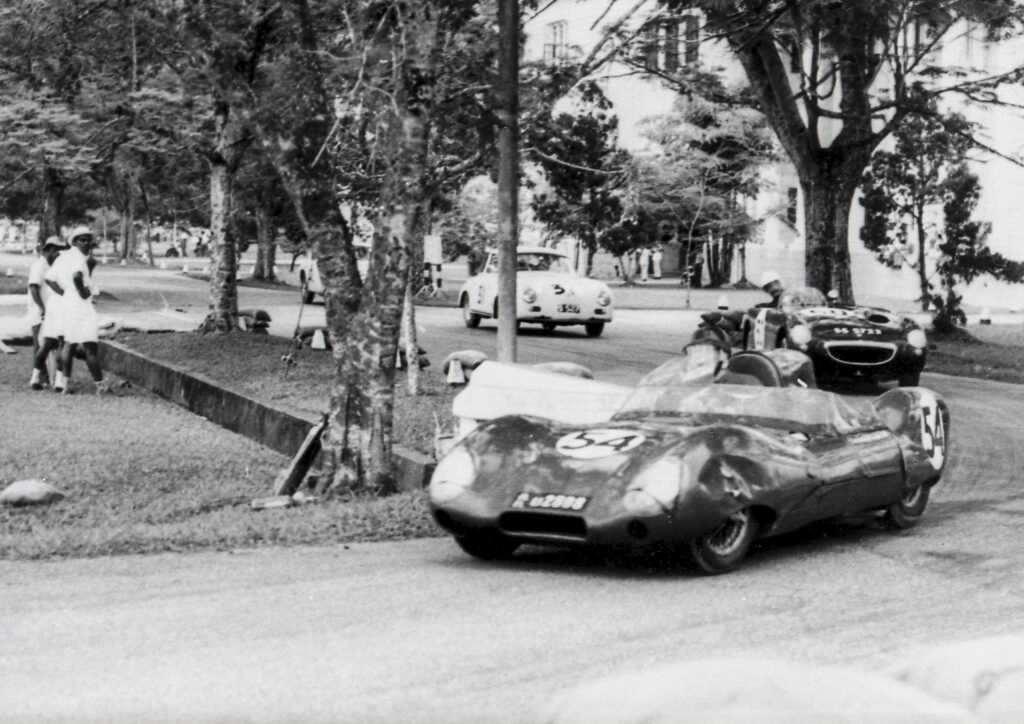
Peter Heath (No.54) had the pace on Bill Wyllie’s Auto Union until he overcooked it at Zoo on lap 43 and retired during the 1960 Grand Prix. He still set FTD, clearly showing what the Lotus Eleven was capable of. Trailing the Lotus is Peter Brown in his #50 Sprite and N.V. Knight9 in his Porsche.
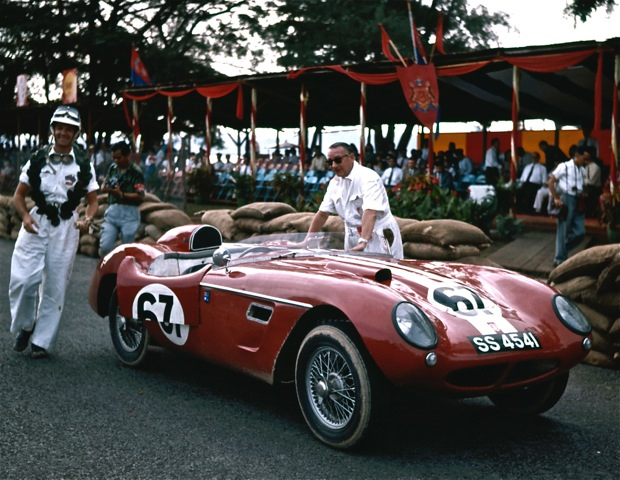
Bill Wyllie raced the Walter Sulke Auto Union RS1000 in the Grand Prix but his Wyllie Mistral Special10 in the 5-lap Race 9 for Sports Cars. He finished first overall and set fastest time (1:59.4) in the race as well.
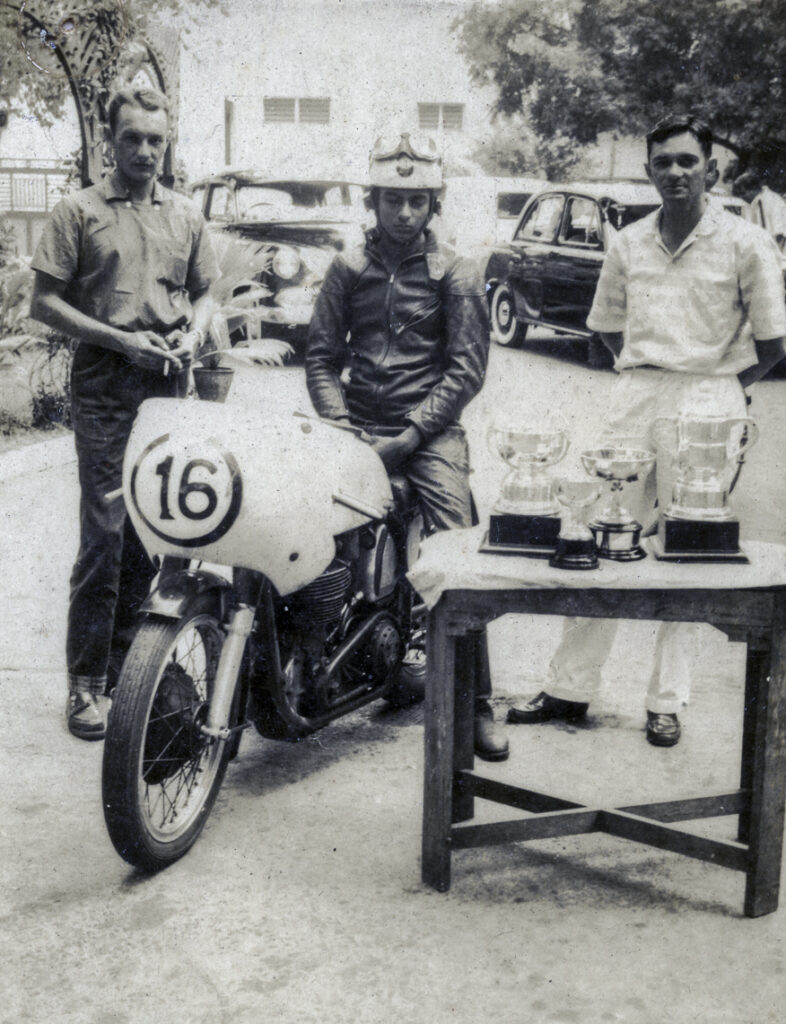
Bhathiya Mirando from Sri Lanka was one of a number of Ceylonese entrants in the motorcycle races. He won the five-lap 125cc and Under support race in his Honda 125, beating K.C. Wong (Honda 125) and Wong Fook Kwong (Honda 125). This photo was taken on 11 Jan 1959 at Madras after he won the triple- crown at the All India Motor Race Meet at Sholavaram. With him are John Webb – Committee Member Bangalore Motor Sports Club (left) and C. Doveton, Hon Sec. of the same club.
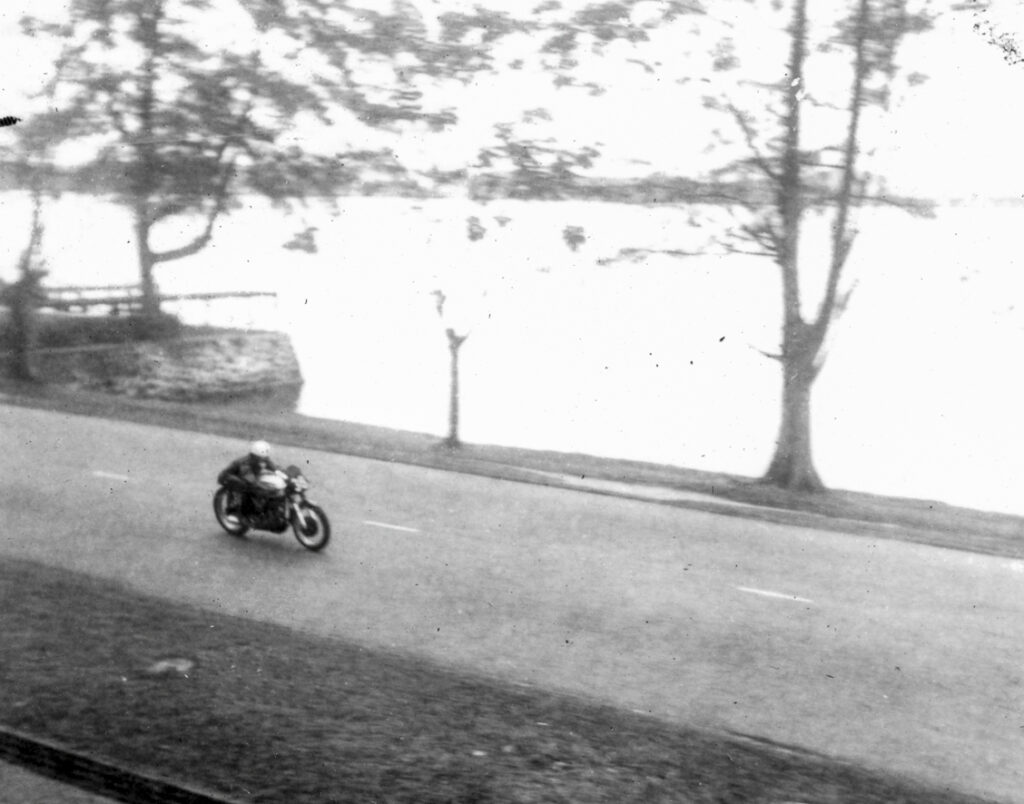
Udumullage Don Jinadasa’s Norton Manx arrived in Singapore in boxes and had to be assembled at Chan Lye Choon’s River Valley Road workshop before it could be sent over to Johore for the Coronation Grand Prix. Jinadasa won the Grand Prix for Motorcycles.
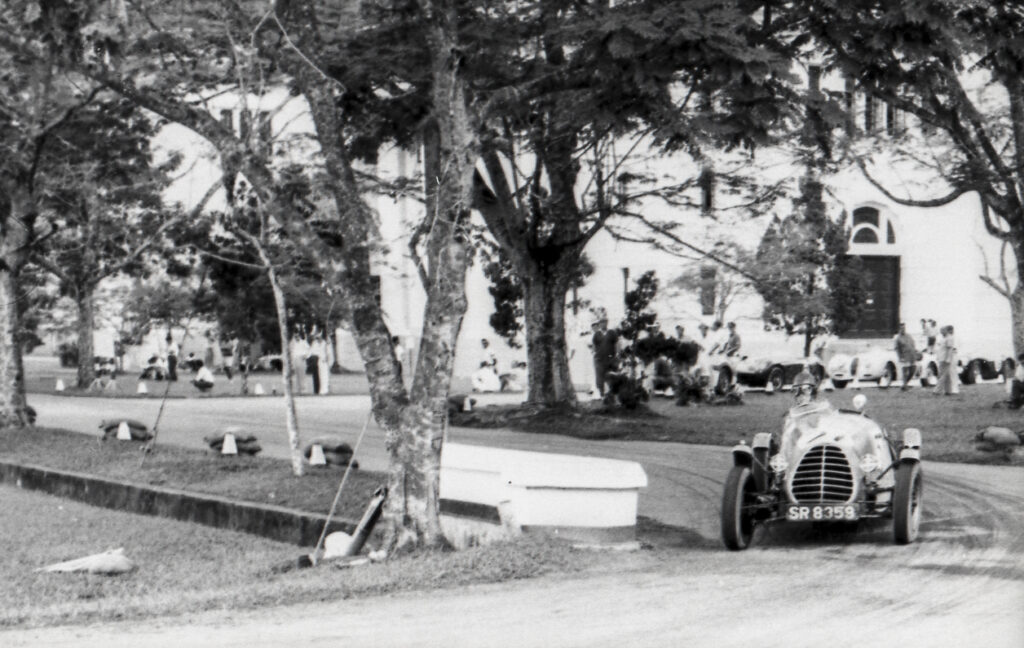
Another of the Malayan Specials in action at the 1960 Johore Coronation Grand Prix – the Supercharged Holloway Special raced by S.K. Yap.
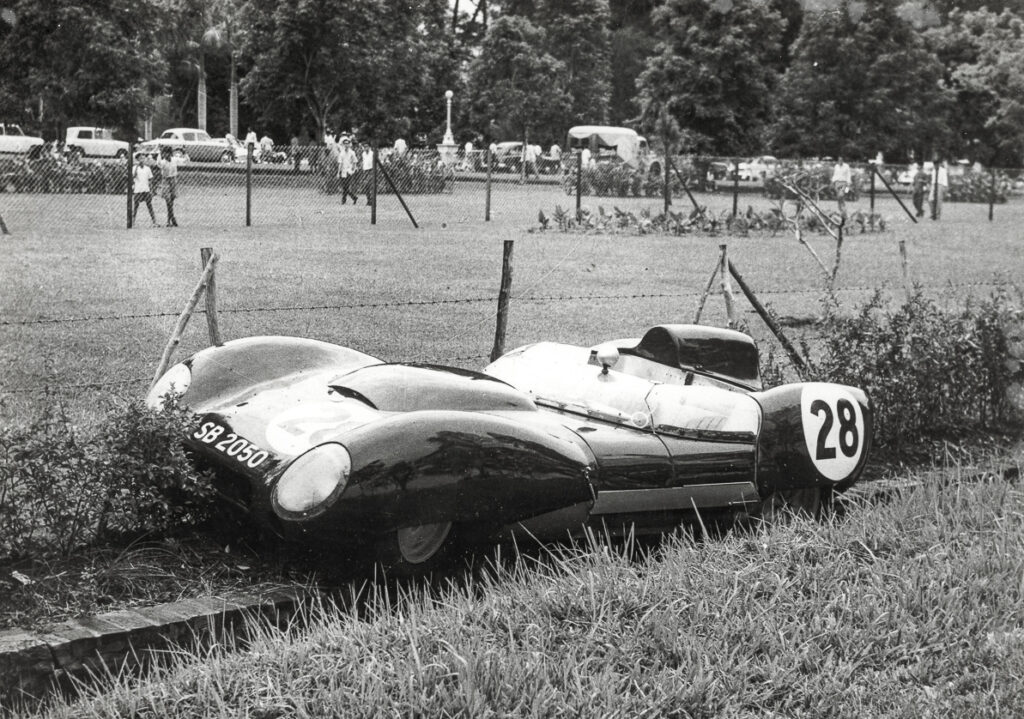
One of the casualties just after the Sultan’s Palace on the Start-Finish straight was the newly imported Lotus 15 of architect Stanley Leong.
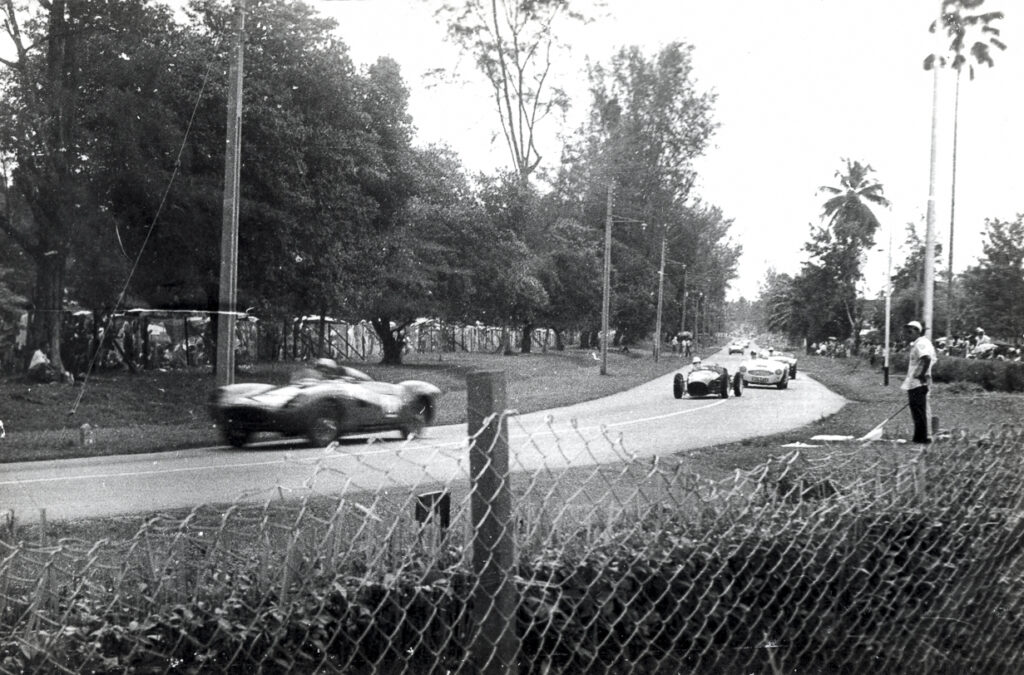
The Grand Prix race showing Jan Bussell’s Ferrari Monza heading towards Garden Bend from Jail Corner.
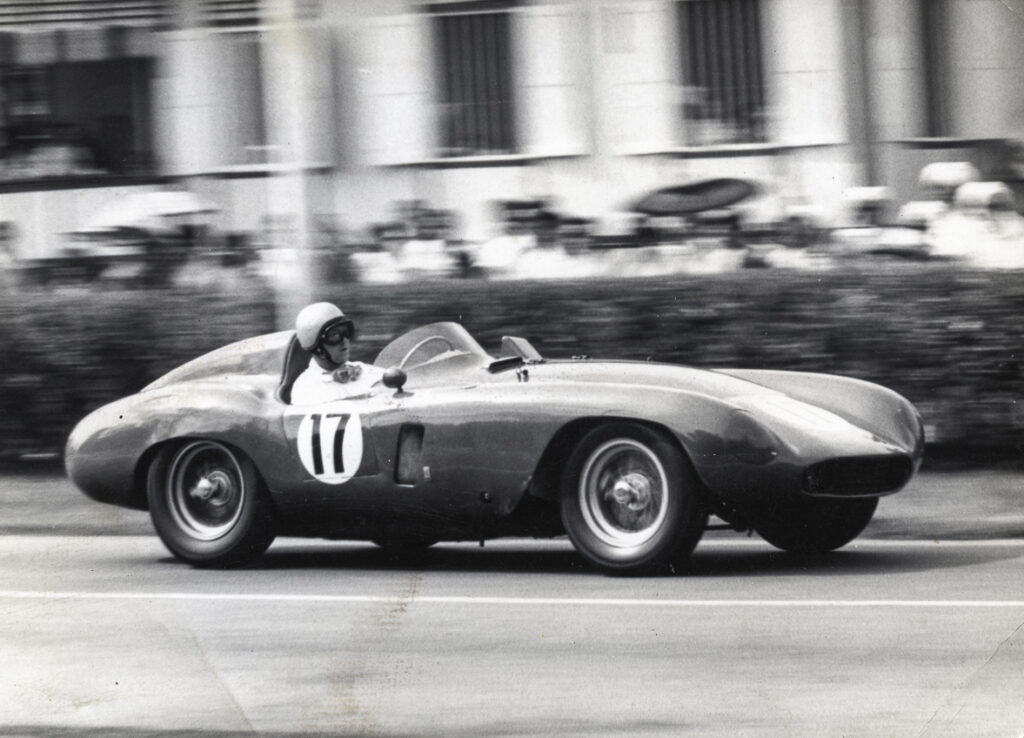
Jan Bussell’s Ferrari in Johore.
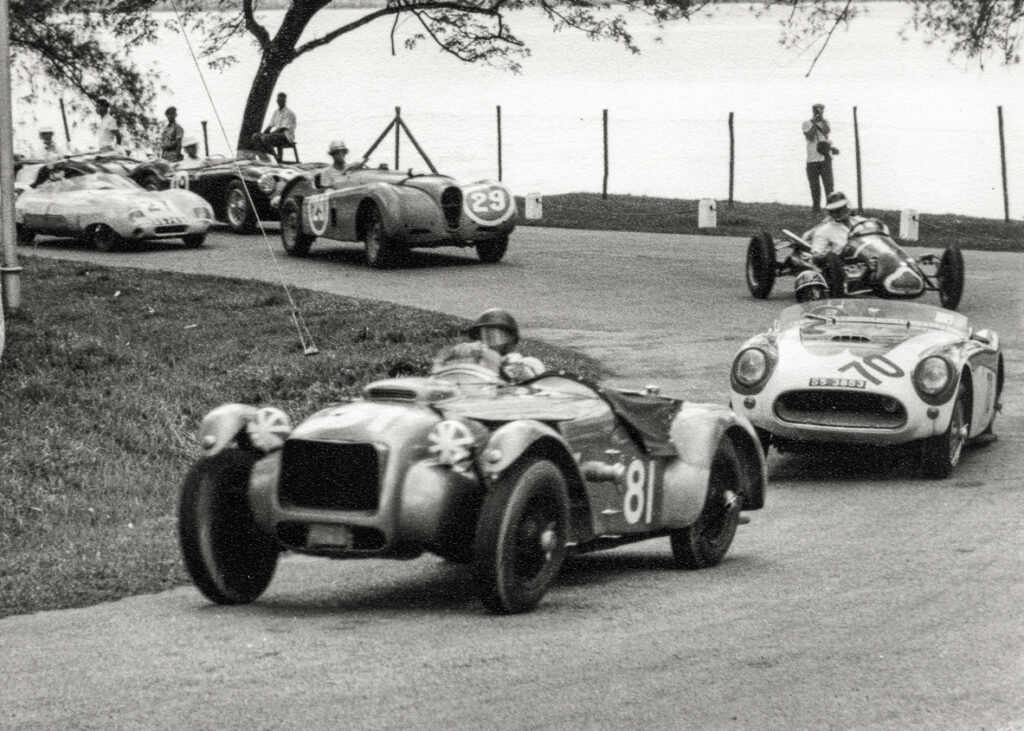
Looking well worn is Phil Caroline’s Allard J2X as he takes on Zoo Corner with a gaggle of eager drivers in his wake. Yong Nam Kee’s Austin Healey 100/4 follows with Jimmy Milne taking the Cooper Francis Bert-tuned Double Knocker Norton (498cc) deep into the corner. Behind the Cooper is Neil Moncrieff’s Jaguar XK140 Special. Tony Huggett’s Lotus Eleven can be seen taking the inside with Chan Lye Choon’s DB3S by his side and Bill Wyllie’s Auto Union behind the Aston Martin DB3S.
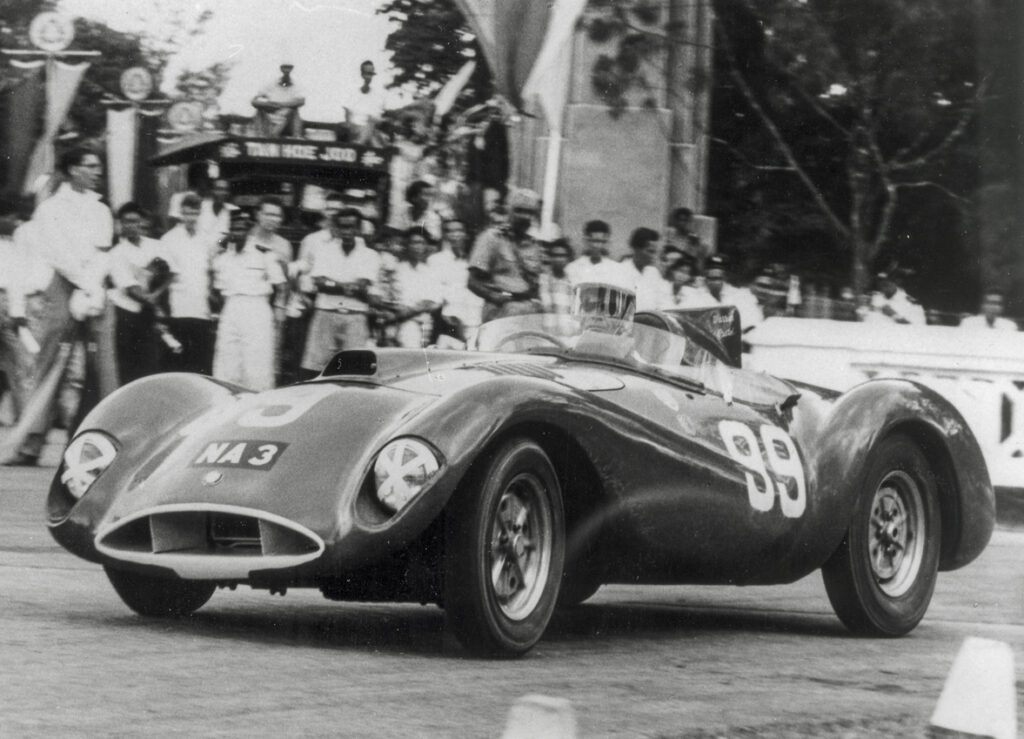
The Warrior Bristol (with remodelled front end with headlight) in action at the 1960 Johore Coronation Grand Prix, the last occasion the car would run with the 1991cc Bristol BS4 motor (the exhaust pipes exited on the car’s right). Shortly after Johore, Arnold installed what was said to have been a special straight-six Jaguar motor, thus turning the Warrior Bristol into the Cooper Jaguar.
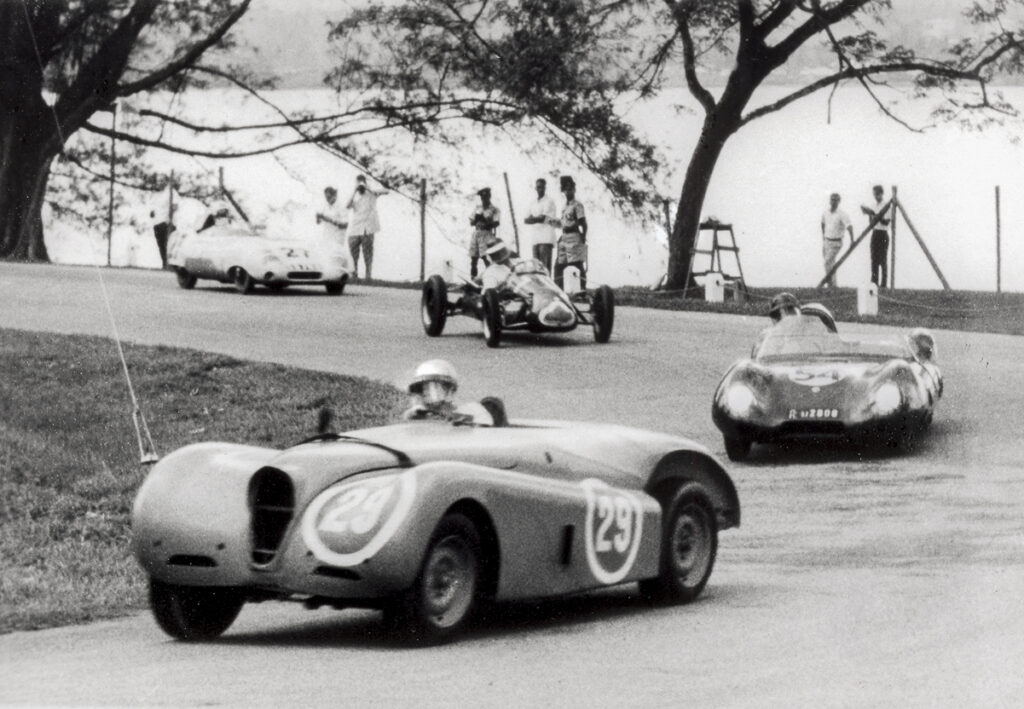
There were several Specials entered for the 1960 Johore Grand Prix but Neil Moncrieff’s Jaguar XK140 Coupe chassis with an XK120 body must have been the oddest of the lot. The coupe body was removed and the XK120 Roadster body, loaned from Singapore Motor Club stalwart Freddie Pope, was fitted to comply with the rules as the Grand Prix race was only open to roadsters.
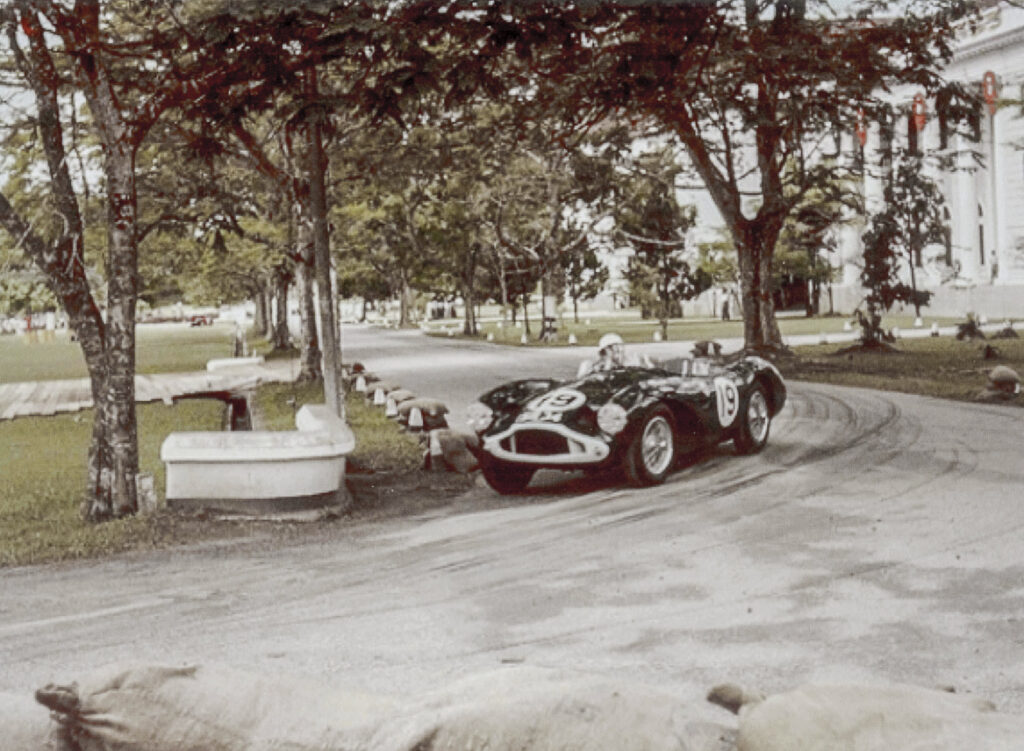
Asia’s most famous Aston Martin11 in action during the Johore Grand Prix in 1960. Owner Chan Lye Choon started the Grand Prix on pole position. There were fourteen finishers at the end of the Grand Prix with Bill Wyllie winning ahead of Tony Huggett, Chan Lye Choon, Neil Moncrieff, Bill Davis and Gordon Haddock. Earlier, Chan had won the 5-lap Support race for Racing Cars.
The wet track separated the men from the boys and here, the more nimble Auto Union had the advantage while the circuit remained wet. Only fourteen cars finished the race with Wyllie’s two-stroke winning ahead of Tony Huggett’s Lotus Eleven Climax, Chan Lye Choon’s Aston Martin DB3S12 and Neil Moncrieff’s Jaguar XK Special. This was a real turn up for the books.
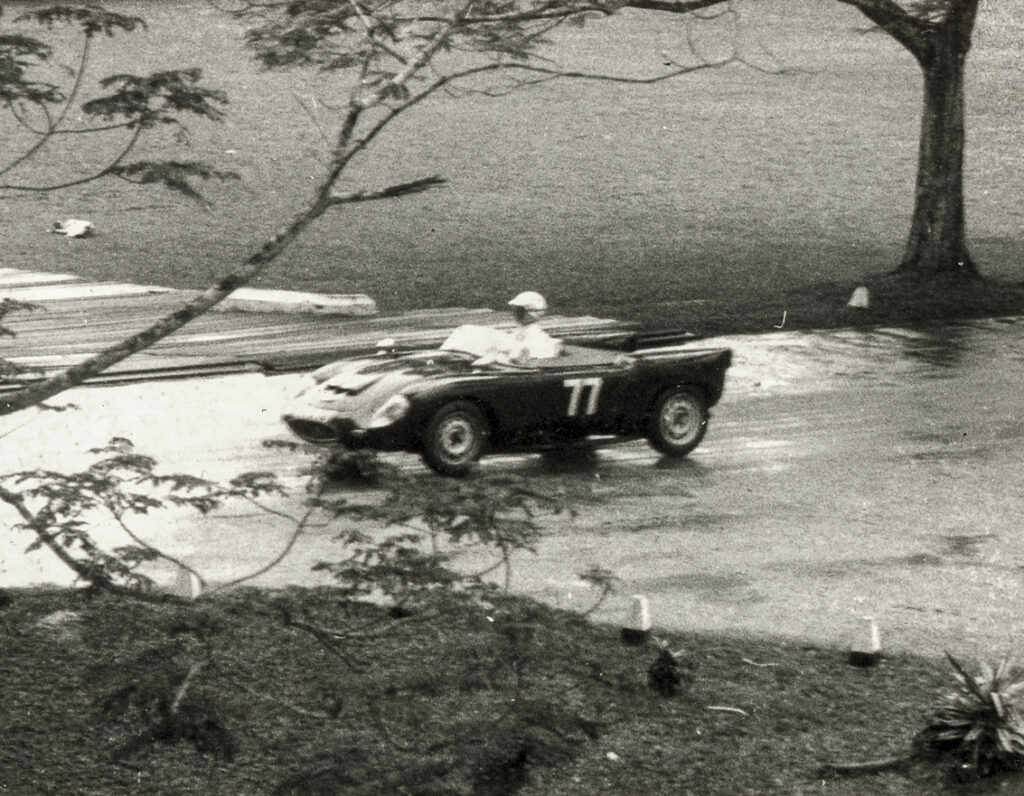
“So why wasn’t Johore on the International Calendar? Because the Macao course exceeds the 200 miles required for this by the RAC. The course allows for a 5-mile lap. It is not possible for Johore to have a longer course, each lap being just over 2-miles. The view that no foreigners had come to compete in Johore as compared to Macao was because some of the best drivers in the region were in the Peninsula. The motorcycle races were supposed to the be best in the Far East without a doubt.” Walter Sulke on the Johore Grand Prix
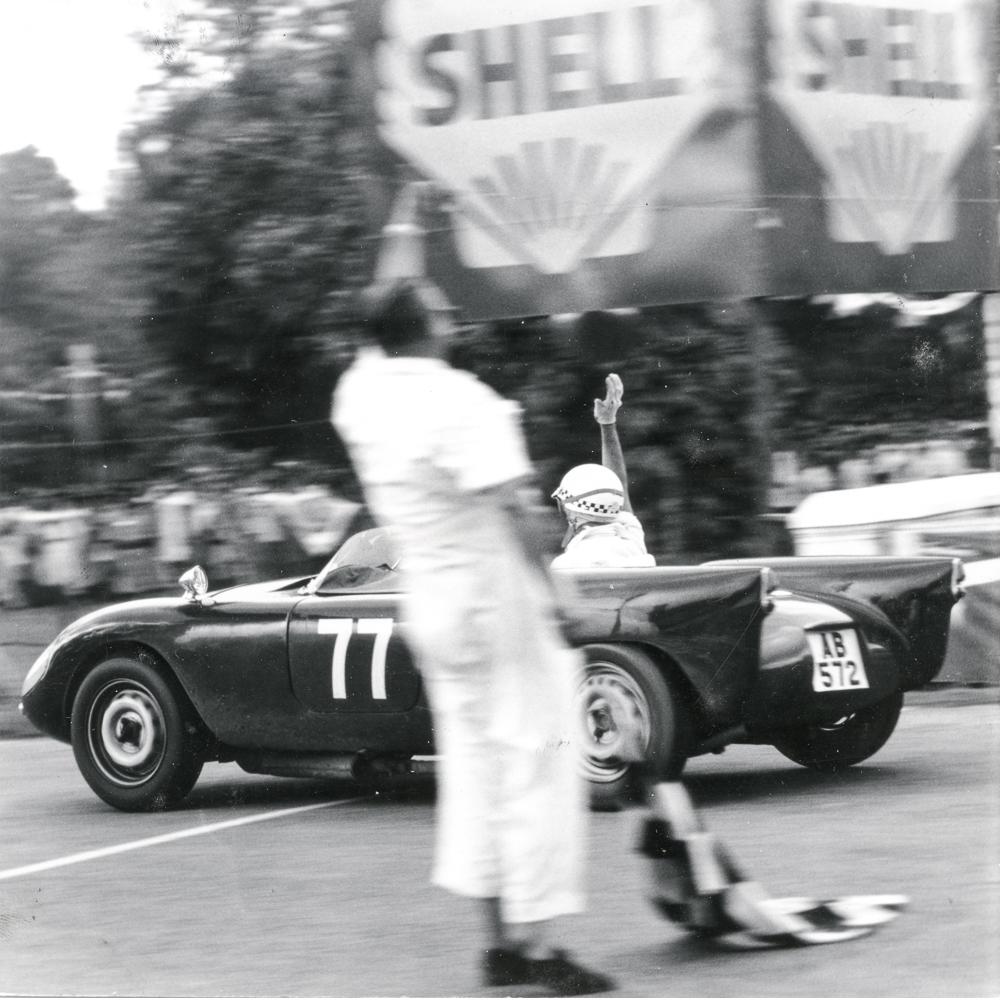
Australian Bill Wyllie wins the 1960 Johore Coronation Grand Prix! 13. A classic photo from the lens of Loris Goring.
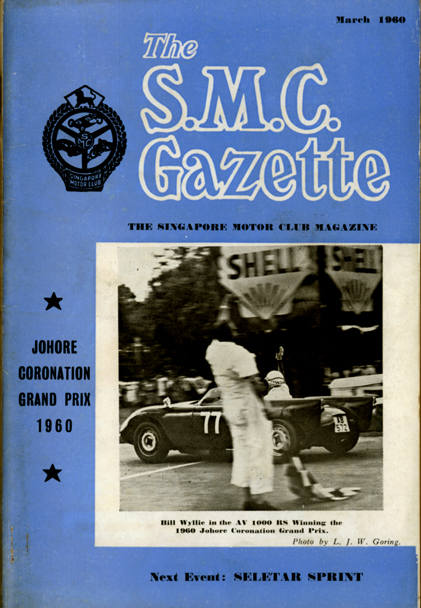
Bill Wyllie and the Walter Sulke Auto Union RS1000 featured on the cover of the Singapore Motor Club’s March 1960 Gazette.
The Johore State Government magnanimously waived the tax on the profits from the Grand Prix and the Sultan personally approved the distribution of S$16,000 profits from the event to eight welfare organizations.
Suffice it to say, the return to Grand Prix racing for the region was an exciting weekend for everyone which included rain, sunshine, broken cars, and late night visits to Amy’s Bar in Johore Bahru. Freddie Pope describe it as such: “The 1960 Johore Coronation Grand Prix has gone down in the history of Far East motor racing as one of the greatest motoring events that has ever been attempted.”
The return to Grand Prix racing for the region was an exciting weekend for everyone which included rain, sunshine, broken cars, and late night visits to Amy’s Bar in Johore Bahru.
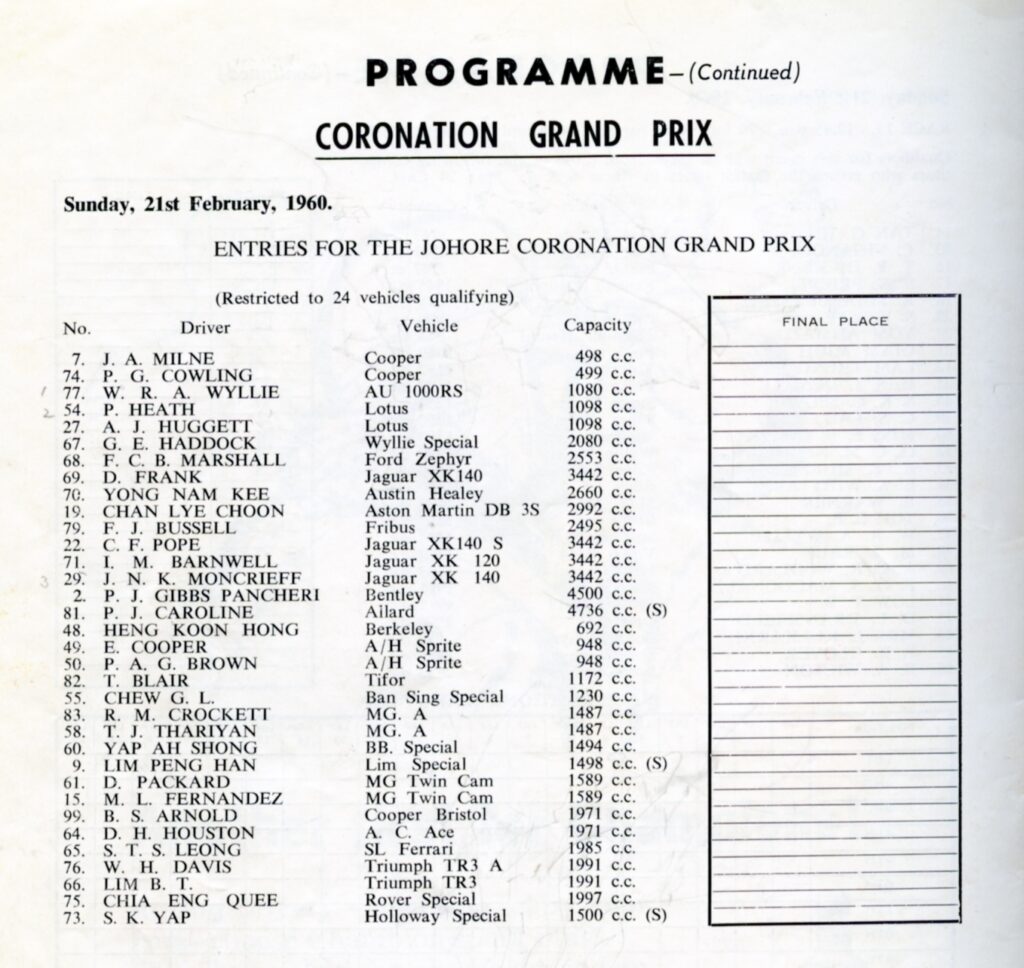
The 1960 Johore Grand Prix entry list. The smallest capacity cars were the pair of Coopers of Jimmy Milne and Peter Cowling while the largest capacity car was Phil Caroline’s Allard J2. The oldest entry was Paul Gibbs Pancheri’s 4.5-litre pre-war Bentley. There were 11 Specials entered, 10 if you omit the Warrior Bristol as a Special. Three of the entries had supercharged engines – the Allard, S.K. Yap’s Holloway Special and Lim Peng Han’s Lim Special.
Rare color footage of DB3S/106 in action – winning the Sports Cars Support Race to the 1960 Johore Coronation Grand Prix.
THE JAPANESE ARRIVE
With the Malayan Emergency over, another in the region emerged – winds of war were around the corner, this time confined to Indochina. Further east, the Japan economic miracle was beginning to manifest itself. This rapid boom was reflective of what was happening across all the automakers in Japan.
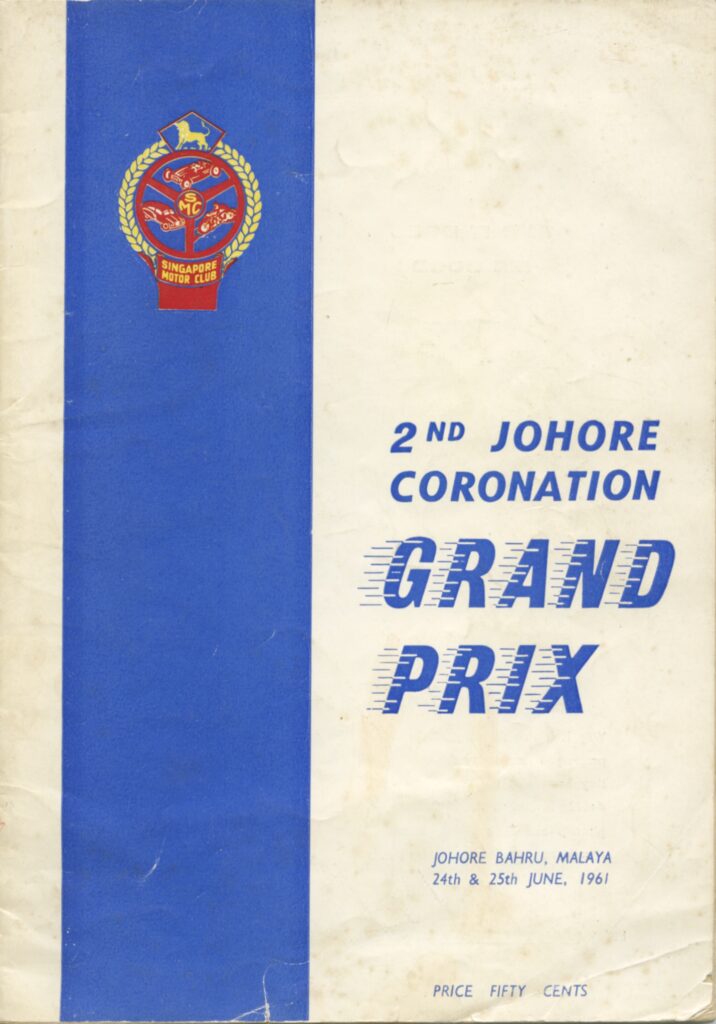
The understated program cover for the event was maintained in 1961.
The 1961 Grand Prix of Johore was pushed forward to June amid a lot of bad publicity led by a very critical Singapore Free Press about the hazards of motor racing. Malayan Railways, having provided special train services for the Grand Prix the previous year, anticipated massive crowds. Rail services were mobilised and visitors now found there was a schedule of 45 Grand Prix Specials that ran between Singapore and Johore Bahru and back, a journey of 45 minutes, over the two-day event. The first train departed at 6.55am on Saturday and the last departed Johore Bahru on Sunday at 10.45pm, arriving back at Keppel Station in Singapore. For those prepared to drive to the circuit, there were also parking facilities for 1,500 cars!
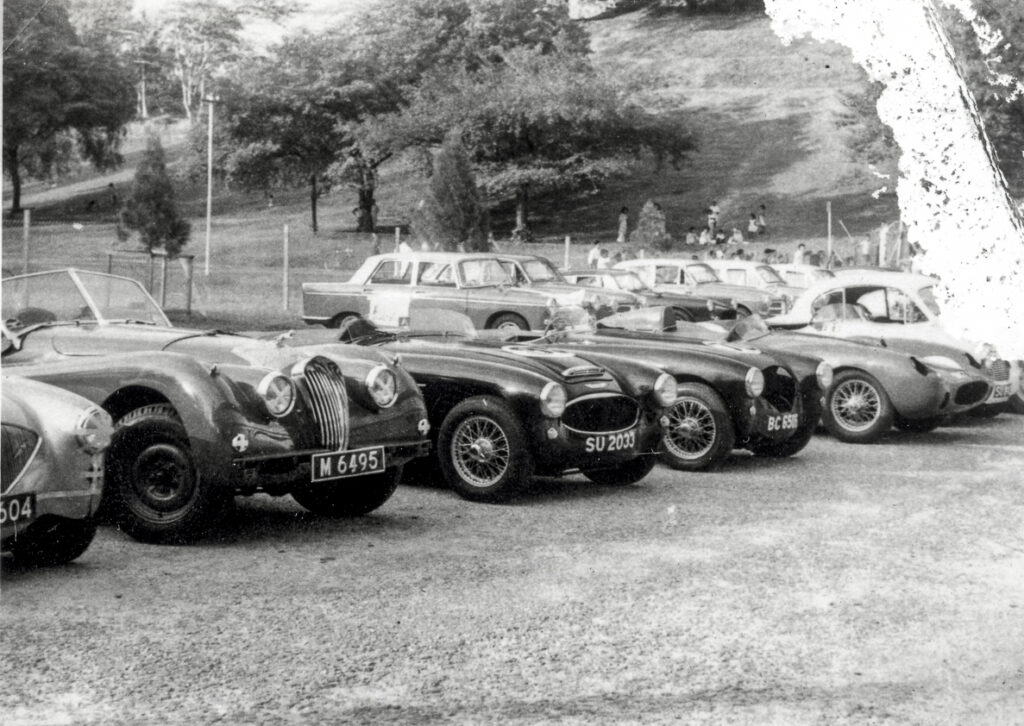
An abundance of big sports cars line up in the paddock in 1961. L to R: M.J.W. Wood’s 100-4 (SF2604); Freddie Johns’ Jaguar XK140 Roadster; Dickie Clinkard’s Rudd Speed Healey 3000 (SU2033); A.A. McLaren’s 100-4 (possibly a 100S) (BC6506); Chew Chek Leun’s Ban Sing Special; W.M. Young’s Austin Healey 100-6 (SU8422); and Peter Todd’s Jaguar XK140 FHC (AB2269).
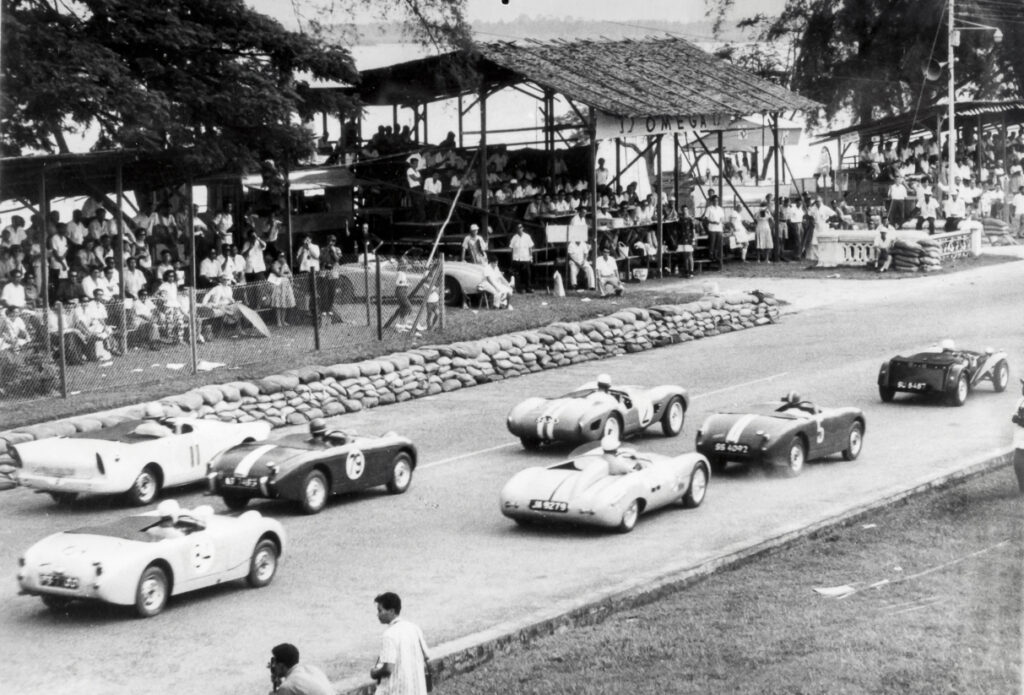
The start of 1961 Race 2 for Sport Cars 1,000cc and under and 1,101cc-1500cc. The leading car appears to be the Lotus Seven of John Armstrong. Directly behind is Eric Cooper in his famous Austin Healey Frogeye Sprite (#5). Next to the Sprite is #2, the Ban Sing Special with 1,230cc engine with Chew Chek Leun at the wheel. Behind Cooper’s Frogeye is the B.B. Special with Yap Ah Shong at the wheel. The lone Sunbeam Alpine in the photo is #11 car of George A. Wills.
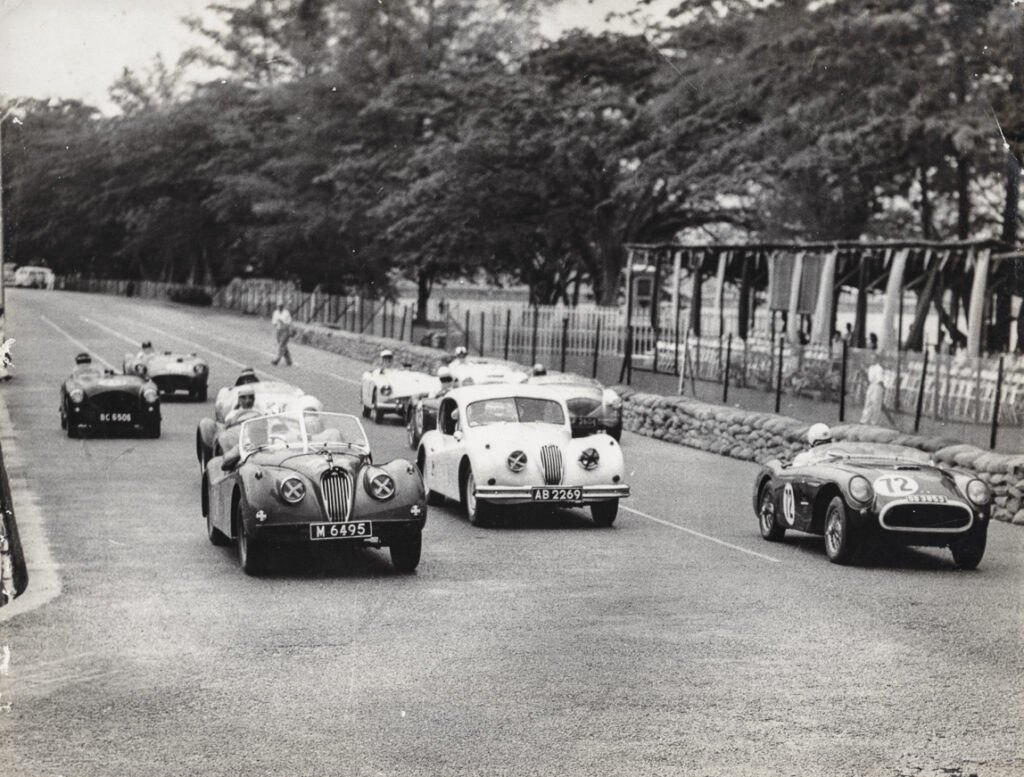
The controversial 15-lap Sports Cars race (Race 5). Yong Nam Kee’s Austin Healey (#72) is to the right. In the middle is #21, Peter M. Todd in the Jaguar XK140 FHC and to the left is Freddie Johns in his #24 Jaguar XK140 roadster. Johns was demoted from first in class to second, giving the win to Peter Todd. Tony Huggett won the overall race in his Lotus Le Mans Climax. Yong DNF-ed on the last lap while in second place overall.
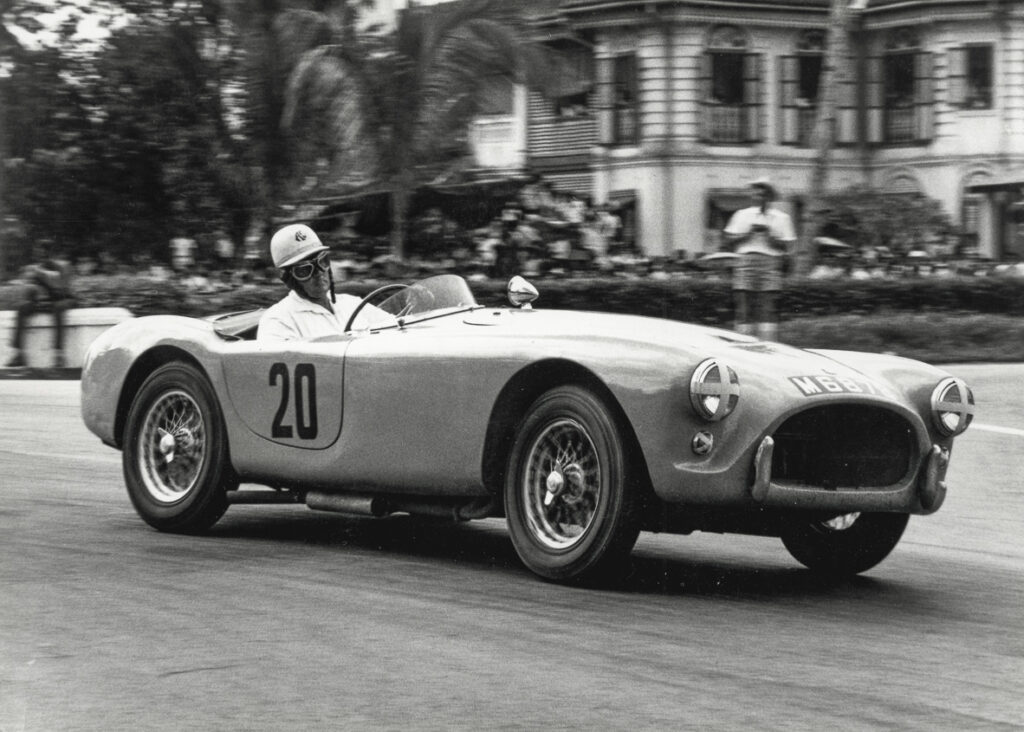
Barry Swann’s Malacca registered AC Ace with Bristol power in 1961.
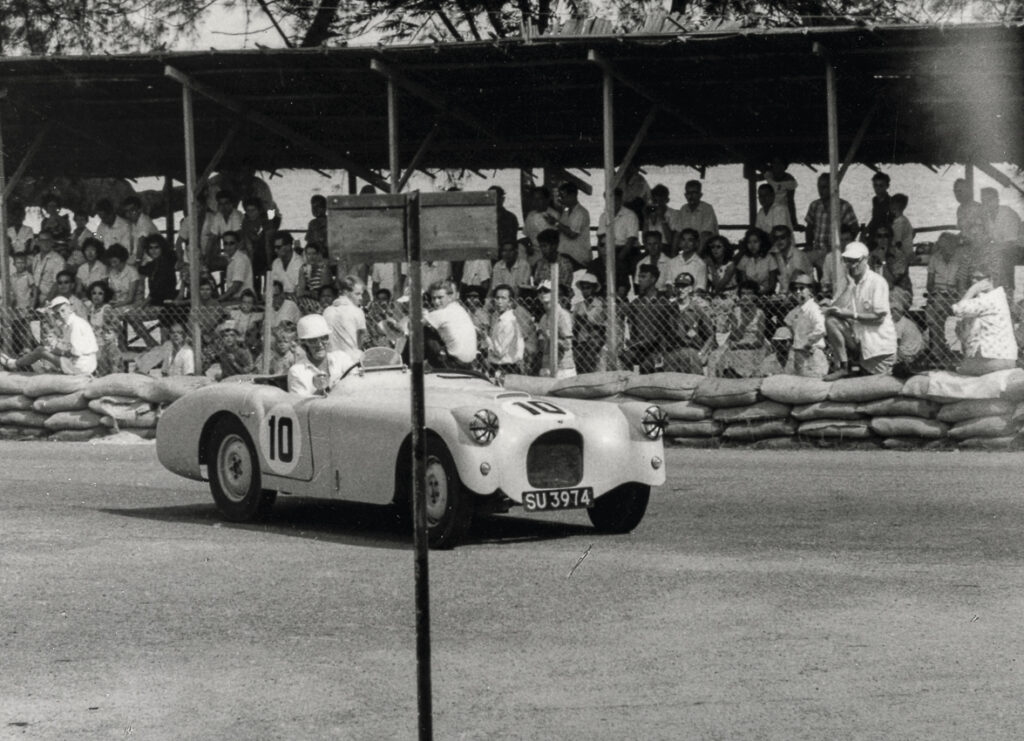
What was this monstrosity? The Fribus of Jan Bussell was raced by Mini-man Kevin T. Murphy that weekend in Johore.
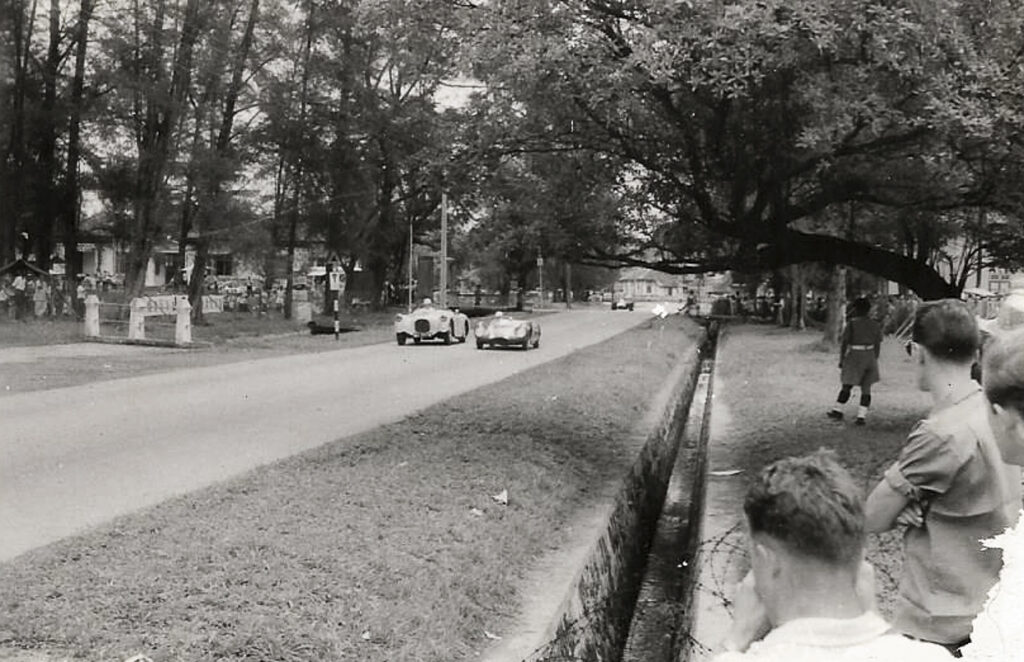
Fribus and Lola Mk1 racing down from Garden Bend to Sultan’s Corner during the 1961 Johore Grand Prix. The Johore Court House is to the left of the drivers.
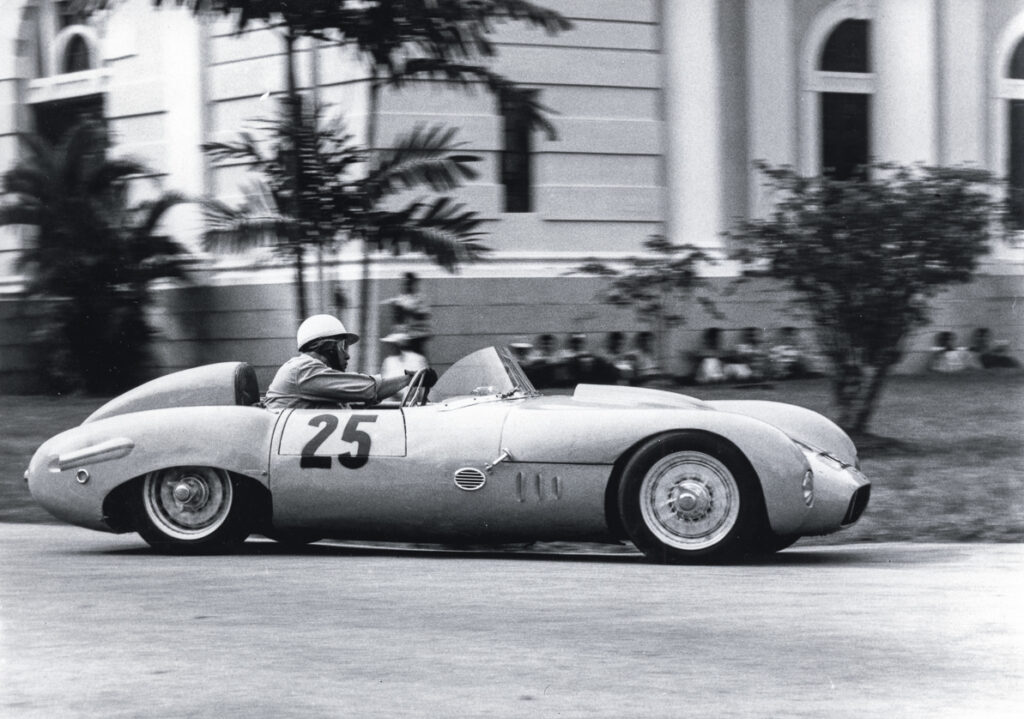
The B.B. 14 at the 1961 Johore Grand Prix. Many mistake this car for the Ban Sing Special Mk1 that was built by construction engineer Chew Cheuk Leun. There are traces of Sergio Scaglietti’s Ferrari 250 TR in both the B.B. as well as the Ban Sing Special.
TWO WHEEL EXCITEMENT
The presence of international riders for the motorcycle races was a first for South East Asia. Even with just seven Japanese bikes entered in the motorcycle Grand Prix, it was a high-powered group, with Honda and Yamaha factory teams present.
The Yamaha factory had riders Osamuri Mochizuki and the well-liked Hiroshi Hasegawa on board. The team had arrived in Singapore by mid-June and were doing 100-mile reliability runs up to Malaysia and back on a regular basis.
Not to be outdone, the very successful Honda Isle of Man TT team flew into Singapore with 24 crates of Honda machines, engines, tools and spares! The locals had never seen anything like this before. Honda’s team consisted of Giichi Suzuki and Teruyoshi Fujii.
The Japanese game plan also involved local riders. RAF Seletar aircraft technician, 23-year-old Chris Proffitt-White15 joined the crack Honda works team, entered with the 1961 RC161 Honda Four, the factory’s current works bike, while Giichi Suzuki had a streamlined 1962 prototype model, the RC162 Four. All this generated enormous regional interest and certainly went a long way to boost the grids and motorcycle sales.
The Johore Grand Prix for motorcycles, the penultimate event of the weekend, was eagerly anticipated. The race distance had been reduced at the request of the Japanese riders due to the tropical heat. There was a total entry list of 51 motorcycles, but the grid would ultimately be reduced to 28 riders with all manner of machines that also included a monster Vincent 998.
Not to be outdone, the very successful Honda Isle of Man TT team flew into Singapore with 24 crates of Honda machines, engines, tools and spares!
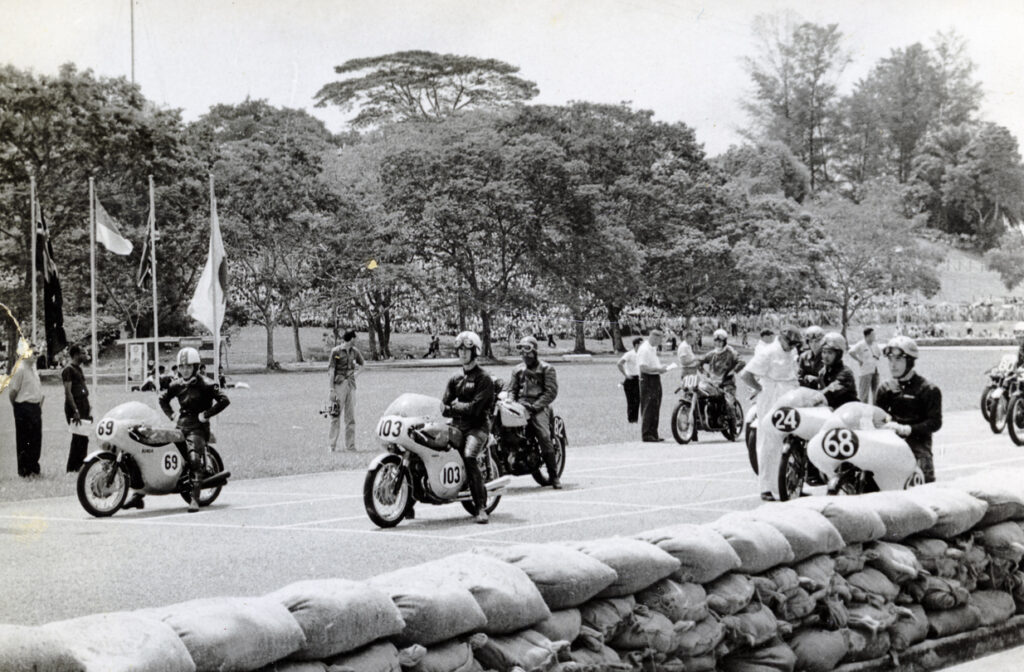
Calm before the storm as Asia’s top riders psych themselves out ahead of the start of the 1961 Johore Coronation Grand Prix. Hondas dominated the front row with Giichi Suzuki (#69) in the RC162 Prototype and Chris Proffitt-White (#103) in the RC161. Yamaha’s Hiroshi Hasegawa (#68) is alongside.
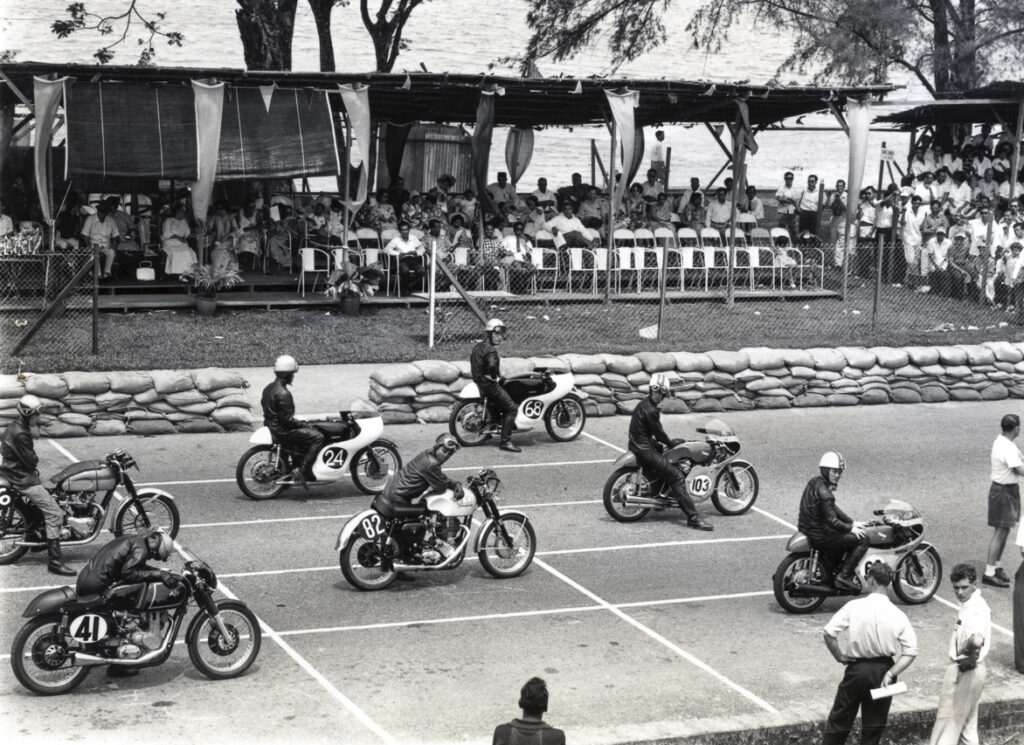
Another angle of the 1961 Johore motorcycle Grand Prix grid.
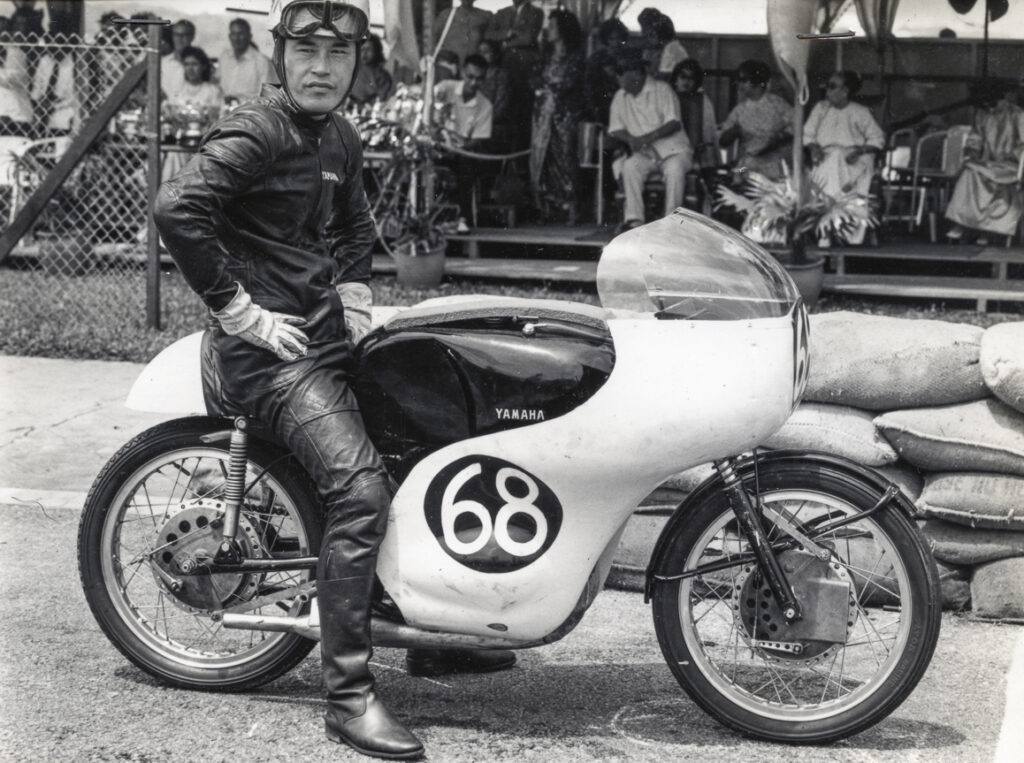
Hiroshi Hasegawa astride his works Yamaha looking over at Chris Proffitt-White and Giichi Suzuki.
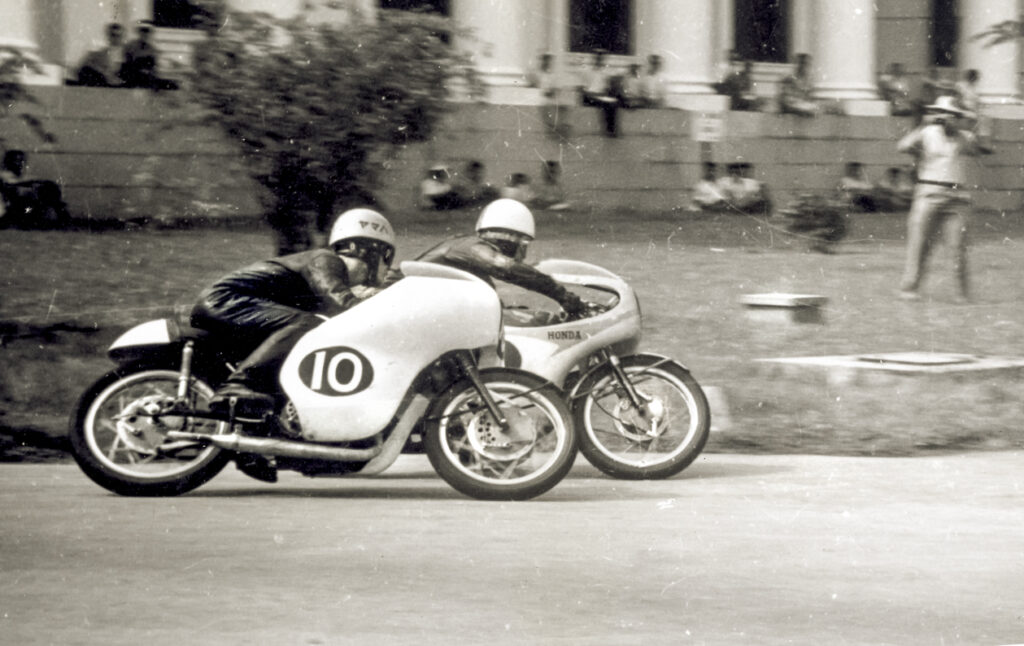
For the first time in motor racing in Malaya, in 1961, the Yamaha factory dispatched two riders with four bikes to compete in the Grand Prix, 27-year-old Osamuri Mochizuki (#10, 125cc Yamaha RD48) and 30-year-old Hiroshi Hasegawa.
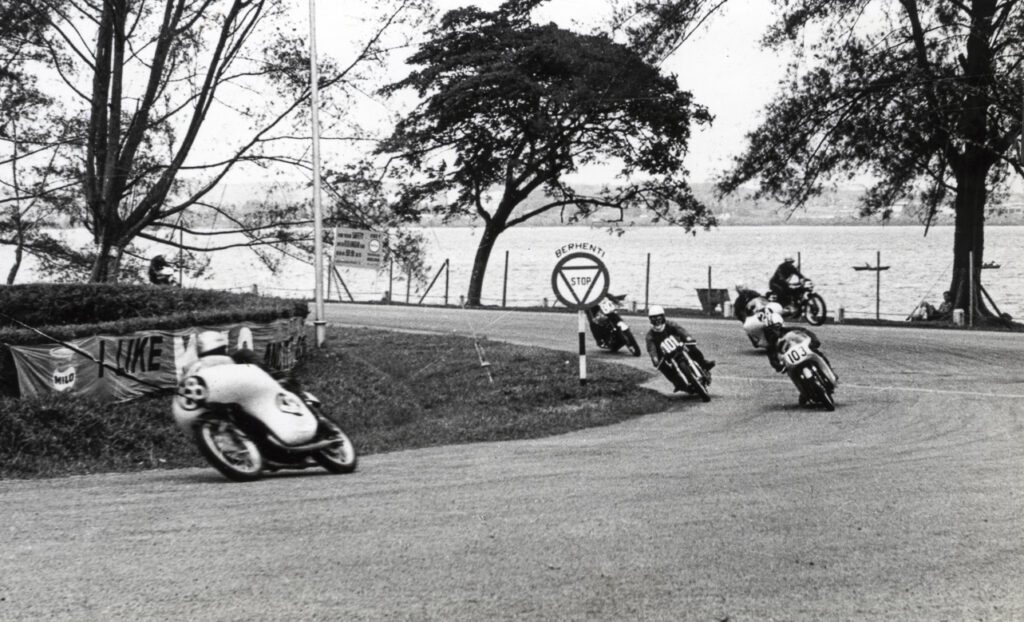
The disparity between the words bikes from Japan and the local entries was alarmingly obvious in Johore in 1961. Hiroshi Hasegawa attempts to stretch his legs at Zoo Corner with Chris Proffitt-White in pursuit (#103).
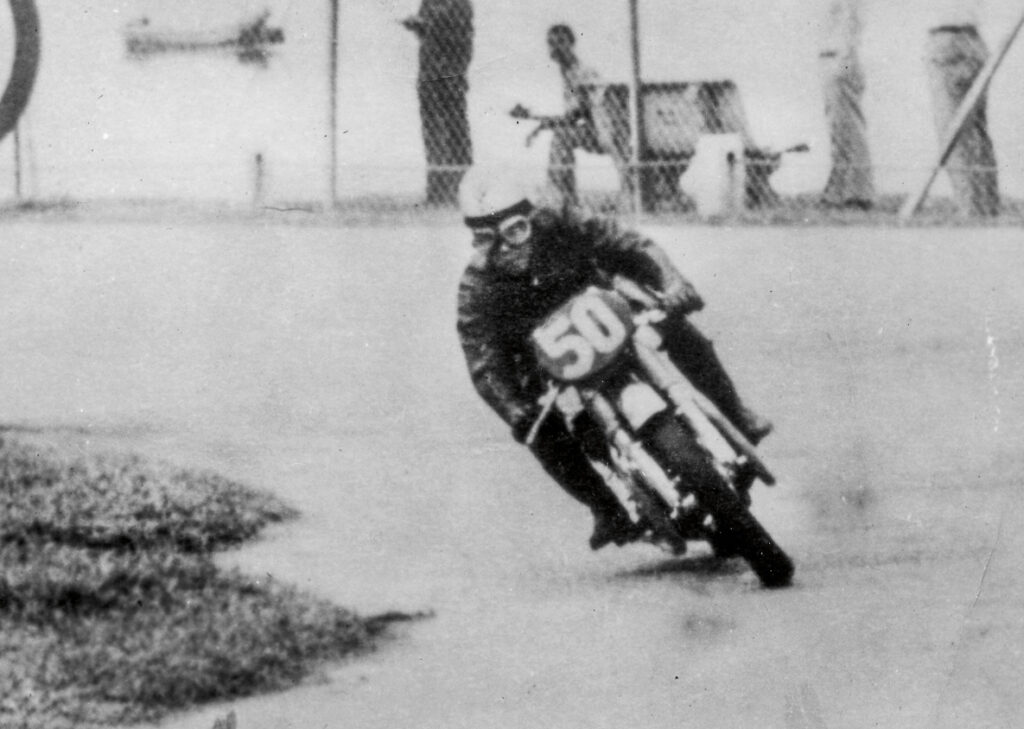
Looi Im Heok, one of Singapore’s top riders throughout the ‘50s and ‘60s, negotiates Zoo Corner in his 498cc Norton during the 1961 Johore Grand Prix.
The full list included eight Indonesian riders. The Indonesian contingent consisted of well-known J.A.J. Grashuis in a JG Special NSU 250, Machtar in an AJS 7R 350, Mahdy in a BSA 350, Ong Sui Ho in a similar bike, Anwari in a Honda 250, Thio Tjeng Dien a BSA 350 and Kang Sioe Tjoan in a BSA 350. Grashuis was expected to qualify although the entrants with the works machines and those with Norton Manx were expected to dominate. There were three Japanese riders representing Honda and Yamaha. If K.C. Wong’s Norton Manx arrived 24-hours before the start he would be able to substitute his Yamaha works machine before the race.
The expected list of qualifiers was expected to include Soh Guan Bee in a Norton Manx, Kuan Huah Chin (yes, that’s Bulldog Kuan) in a Norton 498, Chris Parsonage in a BSA 350, H. Karim in a Norton 600, C.D. Wilkinson in a Norton 498, Chris Teh in a BSA 500, R. Wilkinson in a Triumph 650, Jack Smith in a Vincent 998, Bill Cleugh in a Vincent 998, Wong Fook Kwong in an AJS 350 and Looi Im Hock in a Norton 498. The Japanese works rider Teruyoshi in a 125cc Honda was also expected to make it through qualifying well. Top three expected to be K.C. Wong if he got the Norton, Giichi Suzuki in the Honda and Proffit-White in the Honda. Without the Norton, Wong was expected to finish outside the podium.
As it stood, the race saw Giichi Suzuki’s Honda 250 won with a new lap record of 1 minute 47.1 seconds. Second was Chris Proffitt-White in another Honda, with Malaysia Soh Guan Bee third in a Norton. Honda and Malayan distributors Boon Siew were delighted. Win on Sunday, sell on Monday still worked well.
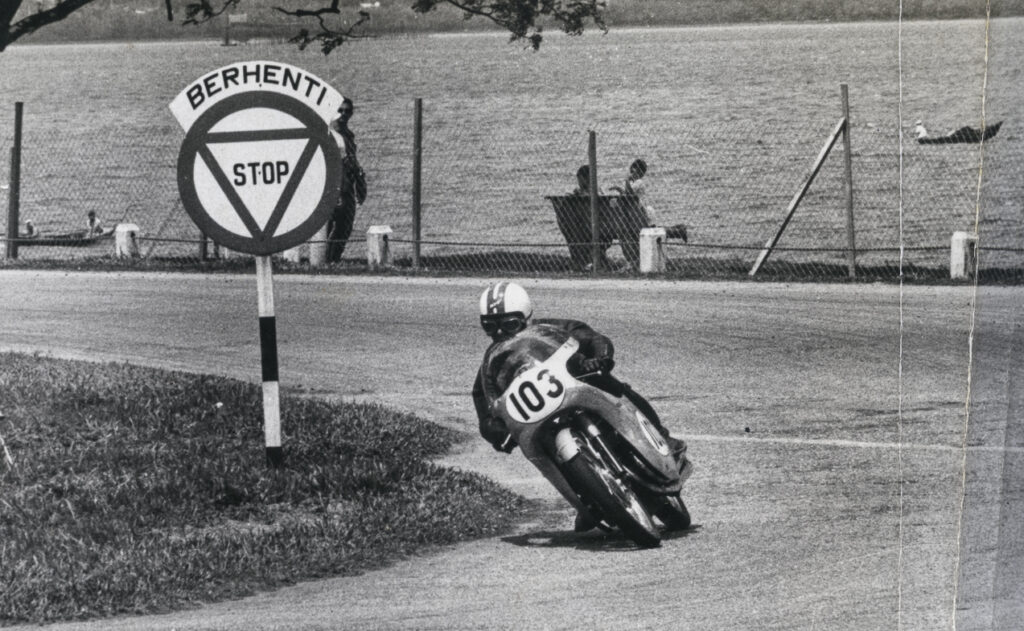
Giichi Suzuki won in his prototype RC162 Honda with a new lap record of 1 minute 47.1 seconds (14.5 seconds faster than U.D. Jinadasa’s time the previous year). Second was Chris Proffitt-White (pictured) in the works RC161 Honda, with Malaysia’s hero Soh Guan Bee third in a 500cc Norton.
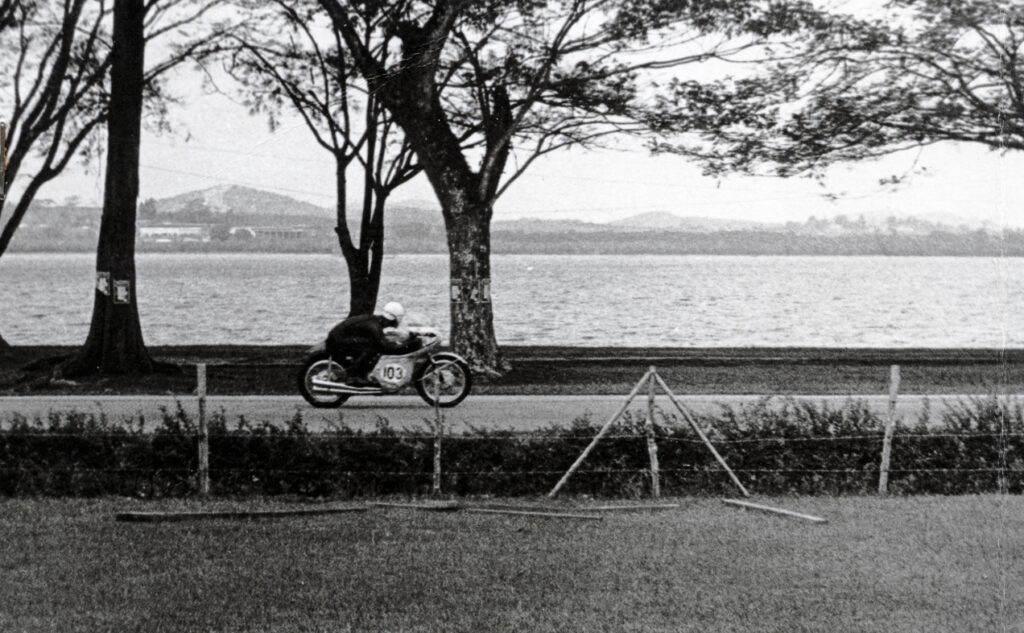
Prof, as Chris Proffitt-White was known as, in the 1961 Honda Four at speed along the main Straight heading towards Zoo Corner in the 1961 Johore Grand Prix.
HER NAME WAS LOLA
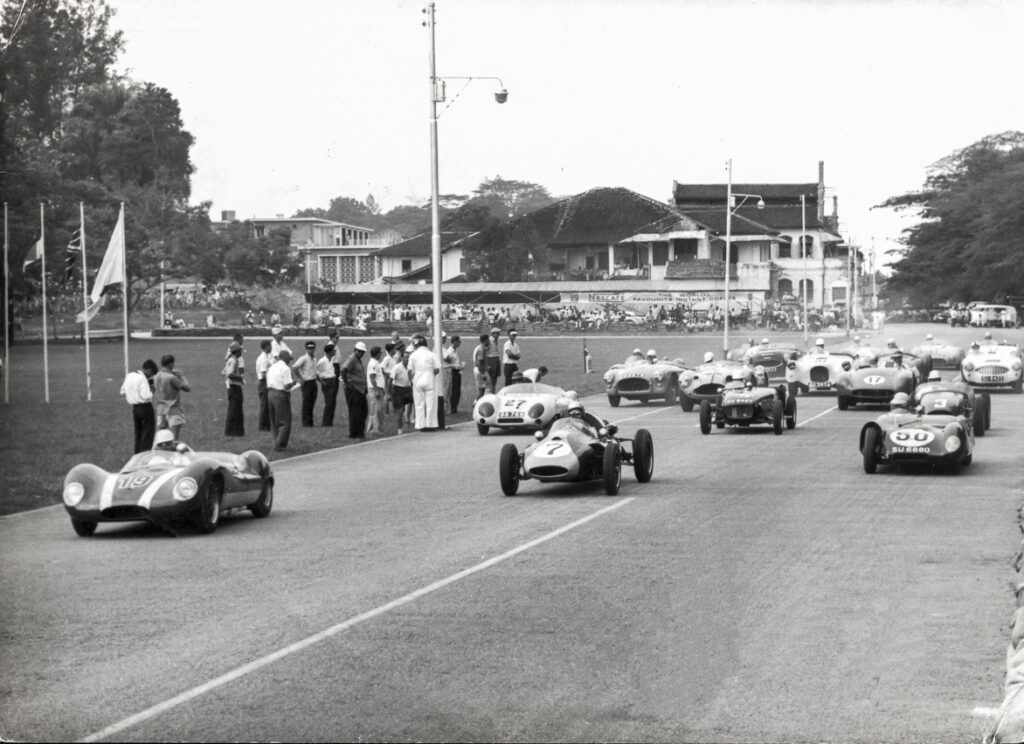
The start of the 1961 Johore Grand Prix. Eventual winner, Chan Lye Choon, leads the pack in his Lola FWE Climax. Following are Peter Cowling’s Formula 2 T51 Cooper Climax (#7); #50 – Peter Brown’s Lotus 17; #27 – Tony Huggett’s Lotus Eleven Climax; #31 – John Armstrong’s Lotus 7 Ford; #3 – Chia Eng Quee’s Eng Quee Rover Special; #17 – Jan Bussell’s 3-litre Ferrari Monza; #10 – Kevin Murphy (in Jan Bussell’s) Fribus; Barry Swann’s AC Ace can be seen to the inside, next to Ian Barnwell’s Aston Martin DB3S.
The final race of the day was the 70-lap Johore Grand Prix for Formula Libre cars, which meant anything from a Morris Mini to a single-seater Cooper F2 car.
The fastest car on the track was expected to be Peter Cowling’s ex-Hardwick 1.5-litre FPF Climax-powered T51 Cooper16. When compared to Chan Lye Choon’s latest acquisition, a Lola Mk1 FPE Climax17, and Peter Brown’s Lotus 17 Climax, the Cowling T51 appeared long in the tooth.
The race saw a wheel-to-wheel battle between Chan’s Lola and Brown’s Lotus 17 for the first ten laps. Cowling then got into the act. Contrary to expectations, the single-seater continued to perform until lap 48 when Cowling was black-flagged for having assistance in getting his car back on track after it hit the sandbags. Chan took the honours after 70 laps, with a fastest time of 1 minute 51.7 seconds. Cowling, however, proved that the T51 was still the fastest in the field, setting a new lap record of 1 minute 49.4 seconds on lap 24, just before crashing into the sandbags. Brown took second and garage owner, Specials builder and tuner Tan Ah Bee, third, in his Ford Zephyr Sports18.
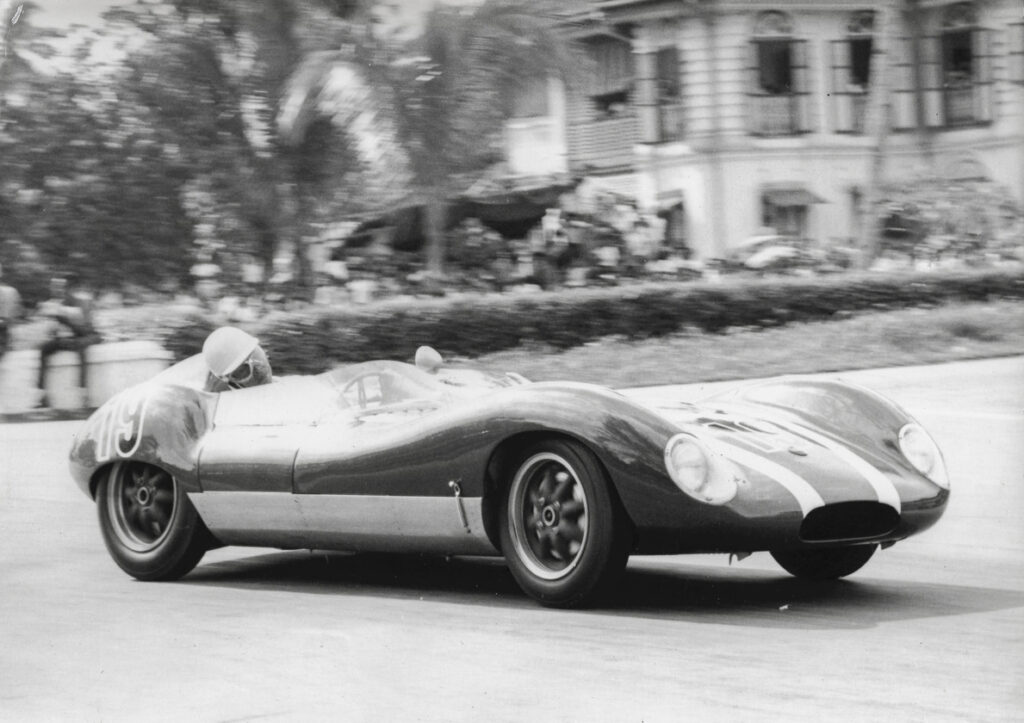
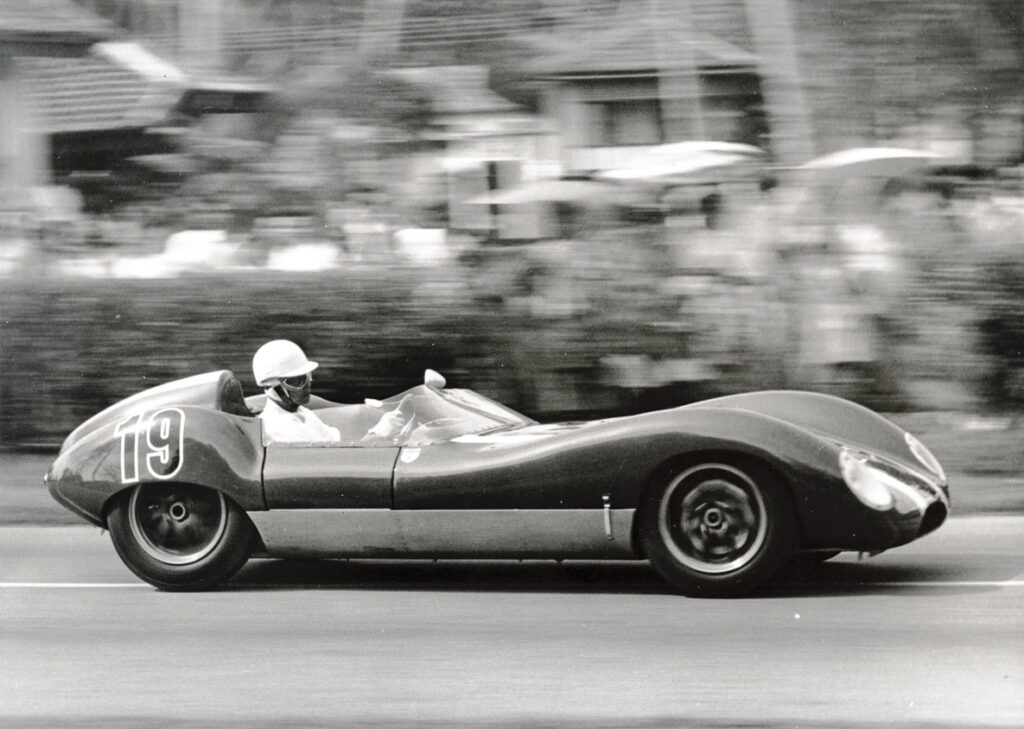
On the way to victory in the Lola Mk1 FWE Climax in 1961.
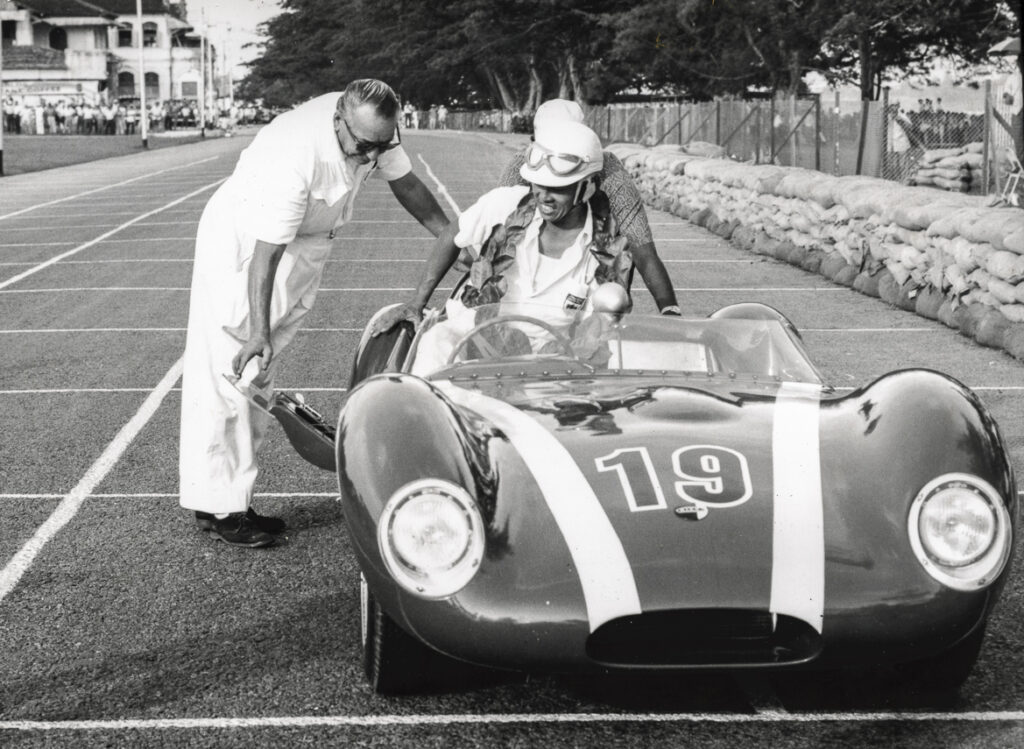
Freddie Pope, father of Singapore motor sports, greets 1961 Johore Grand Prix winner Chan Lye Choon and his Lola Mk1 FWE Climax.
By all accounts, this was a successful event that received some international attention. The competitors packed their bags and headed home, already planning for yet another big Grand Prix – the inaugural Singapore Grand Prix barely two and a half months hence.
TROUBLED TIMES
The following year, 1962, would be best remembered worldwide not for the Rolling Stones’ debut at London’s Marquee Club in July nor by Marilyn Monroe’s death through drug overdose in August, but by the Bay of Pigs and the end of the Cuban missile crisis. Asians were hardly concerned if ninety per cent of US households possessed at least one television set or that the Japanese firms of Panasonic and Sony were about to enter the US market with the first Japanese-made black-and-white televisions. Singapore and Malaysia were suffering growing pains that culminated in a referendum on the formation of the Malayan Federation on 1st September 1962, the prelude of independence from colonial rule in 1963. Hong Kong was dealing with a refugee problem, a very fast growing population, and a devastating Typhoon Wanda. Across Hong Kong’s waters, a casino boom was gripping Macau.
The SMC, organisers of the previous Johore races, who had their hands full with the first Singapore Grand Prix in 1961, were hoping it would be an annual event on the island. Around the region, there were at least 14 motor sports events over the year, including the much-favoured Macau Grand Prix.
These were troubled times on the political front in Malaya. Relations between Malaya and Indonesia progressively deteriorated into what in 1963 would become known as the ‘Konfrontasi’. For the 1962 Grand Prix in Singapore, Indonesians withdrew their entries at the last minute. And there was disappointment too across the Causeway – there would not be a Johore Grand Prix for 1962.
CONFRONTING FEARS
The reconstituted Federation of Malaya (comprising Malaya, Singapore, North Borneo, Brunei and Sarawak) in 1963 yielded an unexpected adverse reaction from neighbouring Indonesia, and a campaign of military insurgency ensued from early 1963. Surprisingly, motor racing was unaffected by any of this. The Grand Prix sabbatical lasted just a year.
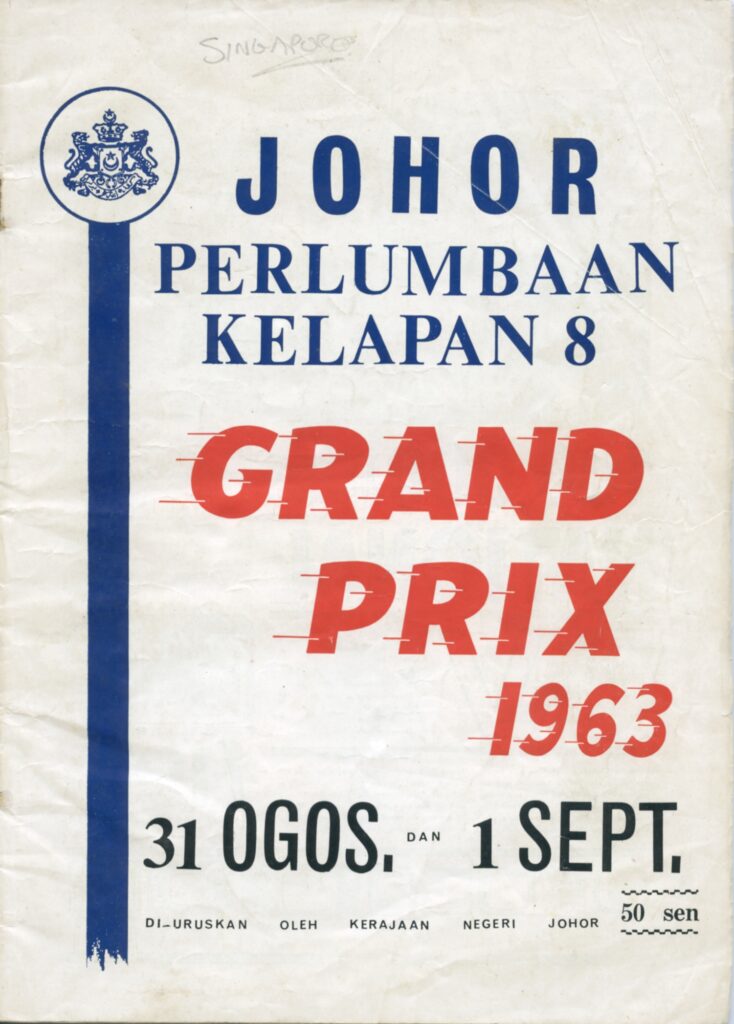
After a lapse of a year, the Grand Prix returned in 1963. Once more the cover design was somewhat understated.
The Malaysia Grand Prix (held in Singapore) got off to a good start in April 1963; Hong Kong’s Albert Poon won in his Lotus 2319. At the end of August, 15,000 tickets were offered for the Johore Grand Prix weekend, where the track was subtly revised.
The new Johore street circuit was now 433 yards (396 metres) longer totalling 2 miles 543 yards. The layout was similar, the location the same but there was now some road widening and resurfacing that had taken place earlier.
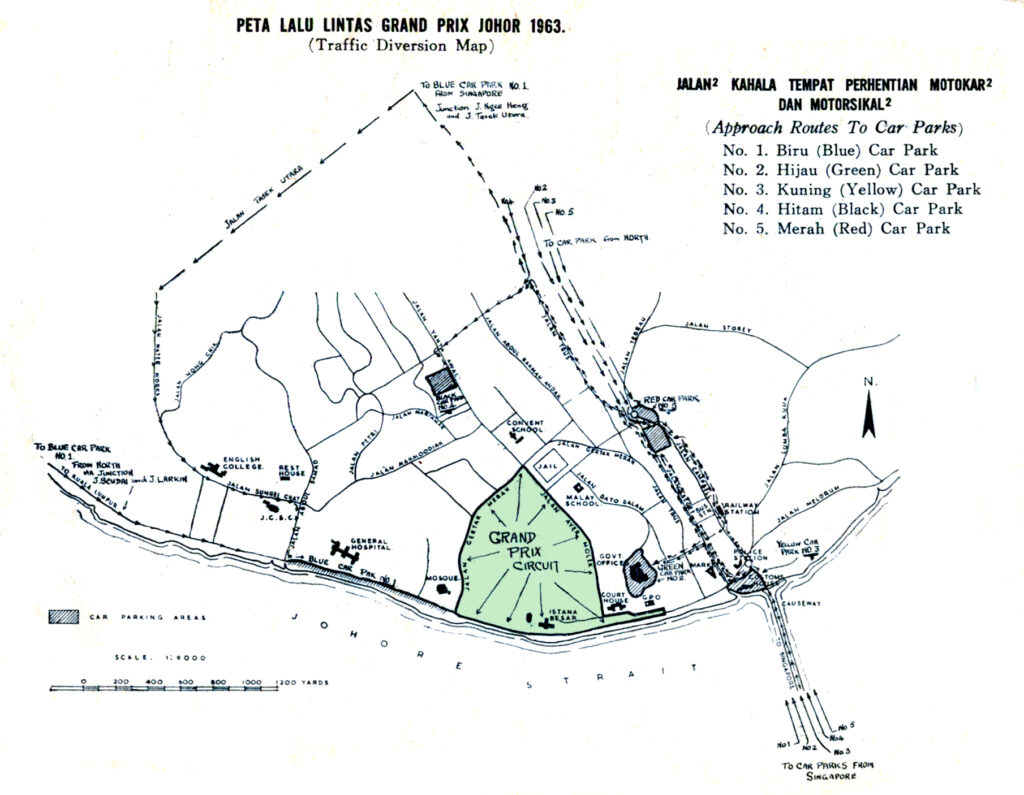
The traffic divergence map provided in the 1963 Johore Grand Prix program showing the proximity of the Malaysia-Singapore Causeway to the circuit. One could almost watch the proceedings from Bukit Timah Hill in Singapore.
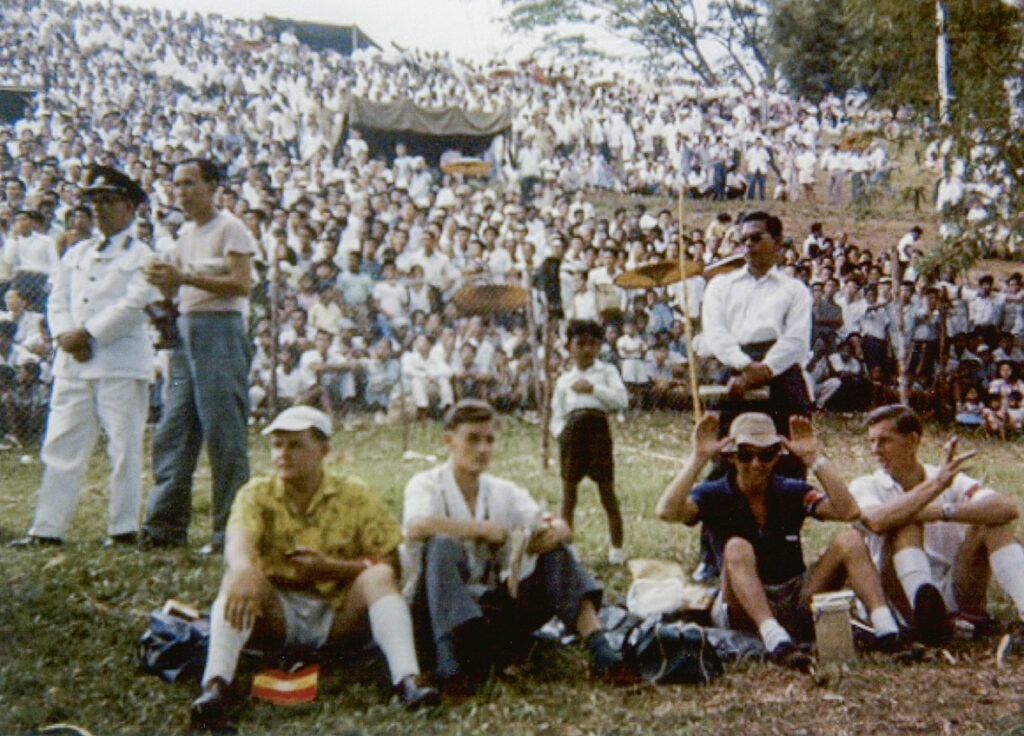
A pleasant day out in Johore for motoring enthusiasts.
There was much at stake on the motorcycle front. Once again, Yamaha entered a works-backed team. In the Saturday motorcycle Grand Prix, Fumio Ito set fastest lap time of 1 minute 48 seconds on his way to victory, with Yamaha works teammates Yoshikazu Sunako and Terry Nightingale in close pursuit, making it a 1-2-3 for the manufacturer. Win on Saturday, sell more bikes on Monday. A new market had opened up for the Japanese motorcycle manufacturers.
OMENS
Perhaps as harbinger of things to come, there were a number of incidents even before the weekend began. Stanley Leong’s Merlyn Mk6 Sports Car caught fire and burst into flames during practice on Friday as a result of a short circuit in the wiring. Leong had the car out for run around the circuit after having had gearbox trouble earlier. The car caught fire and Leong was seen leaping out of the car before it burst into flames. Another driver in trouble was Dickie Arblaster, his new Austin Cooper overturning while taking a sharp bend. There were no fatalities before the Grand Prix…
Friday’s trials also saw Yong Nam Kee put up the most impressive performance in his Jaguar D-Type, the car setting the fastest lap with ease in 1 minute 50.1 seconds, a whole two seconds faster than Peter Heath’s lap record set in 1960, albeit over a slightly shorter course. The D-Type was touching 140 mph on the straight and Yong said that he could have increased the speed but for certain sections of the road being slippery. Hong Kong entrant, John Kirk, driving a Lotus 18 Formula Junior, was only half a second behind Yong’s fastest lap time.
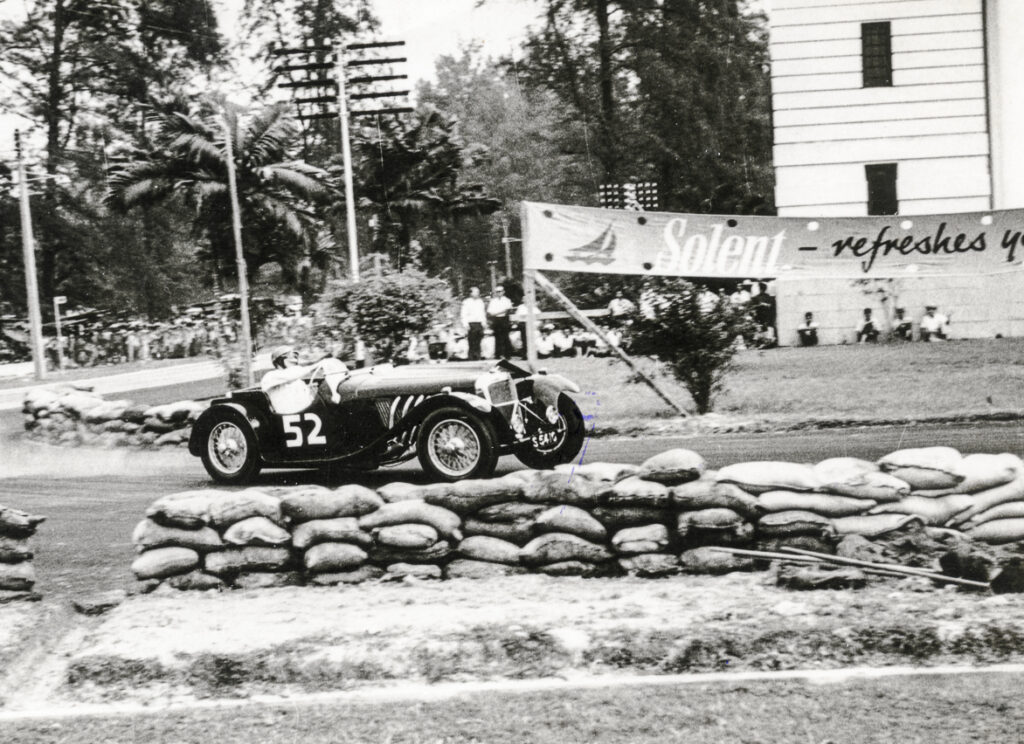
Alan Lowe in his SS100, now with 3.5-litre motor. Lowe finished third in the 1963 Vintage car event held on Saturday morning.
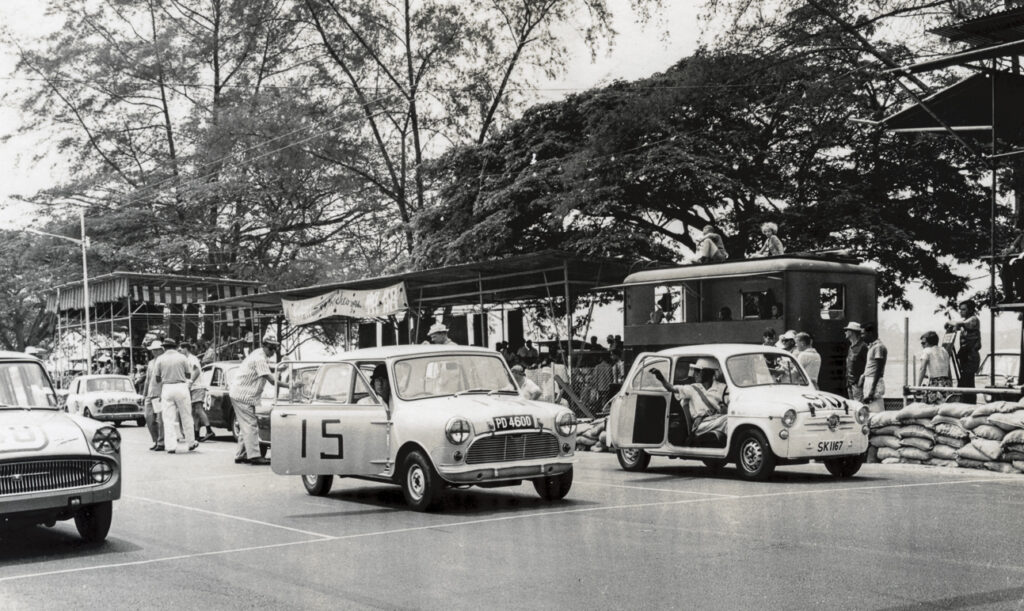
The 10-lap Race 4 (The BOAC Trophy Race) fir Saloons & Tourers combining 1,000cc and under, 1,001-1600cc, and 1,601cc and over classes. On the front row L to R: Robert Lee – Toyota Toyopet Tiara 1,900cc; Tim Blair – Mini Cooper 998cc; Lim Peng Han – Fiat Abarth 982cc.
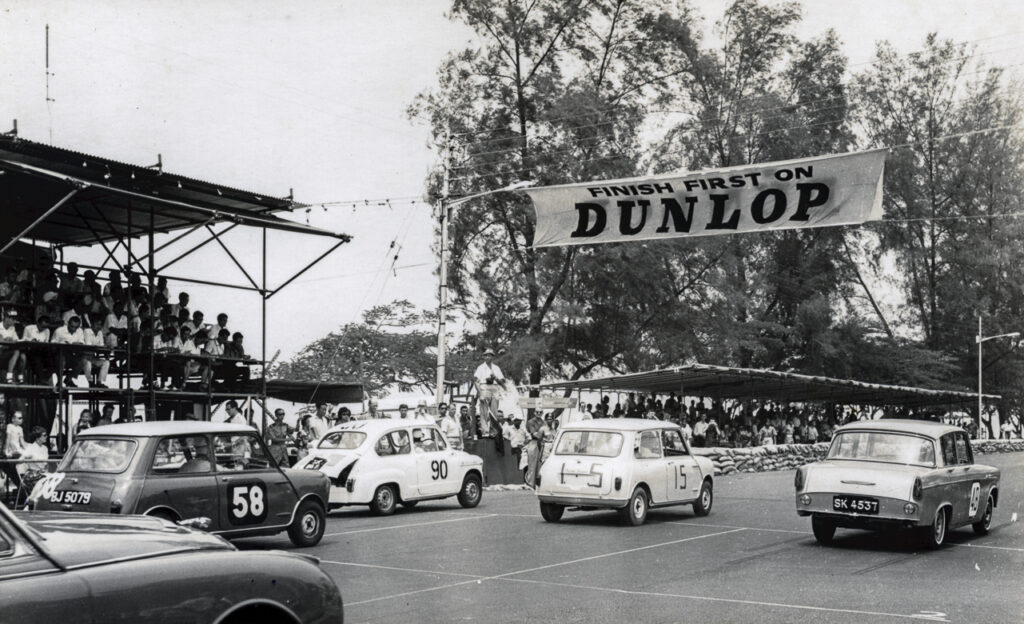
The local seemed to think that the Abarth drivers left their boot lids open deliberately. To the left is the only Jaguar in this race, Dick Clinkard’s Endeavour, a 3.8 Mk2.
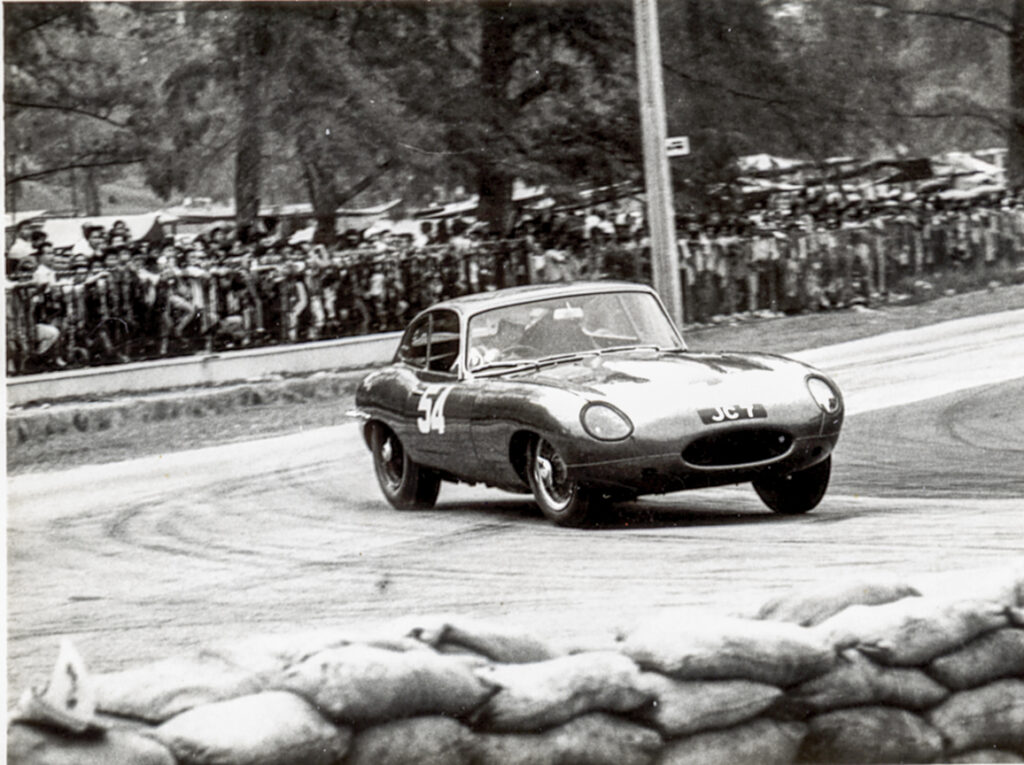
Engineer John Wright took a fine second place finish in the Sports Cars support race for the 1963 Johore Grand Prix. The E-Type Coupe finished behind Yong Nam Kee’s E-Type Roadster.
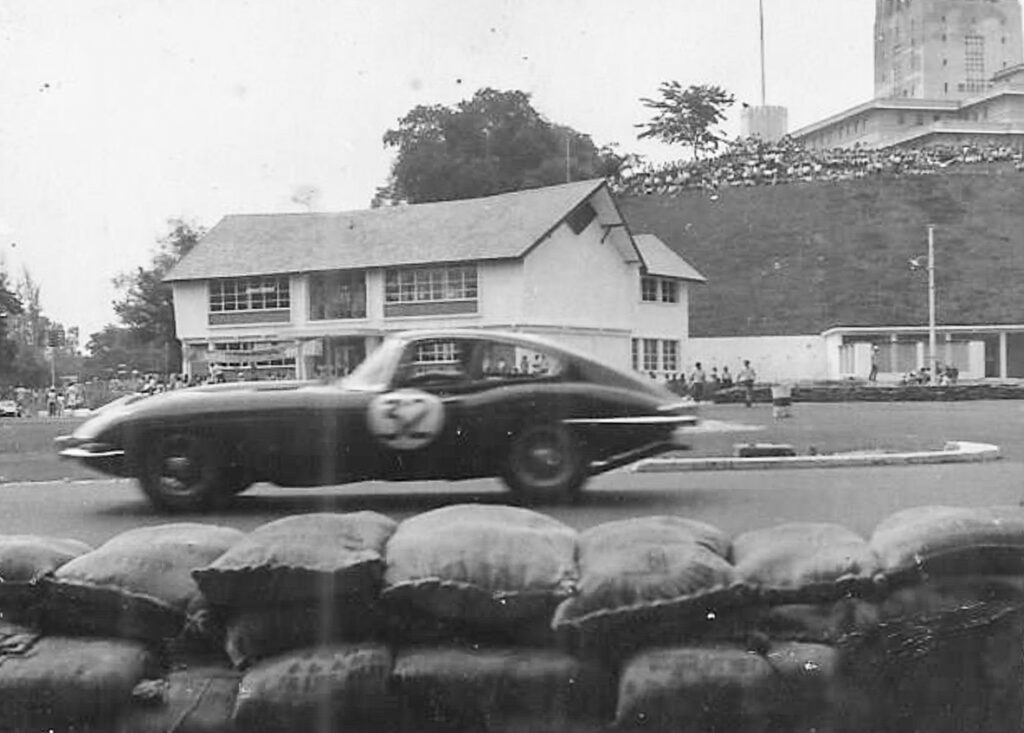
As was rightly pointed out to this author, this wasn’t John Wright’s Jaguar E-Type Coupe in the 10-lap Sports Cars race but Alan Bond in his #32 E-Type Coupe (which had its bumpers on in comparison to the Wright car, which was sans bumpers). Bond’s Coupe was soon put on the market for sale, with an asking price of S$12,000.
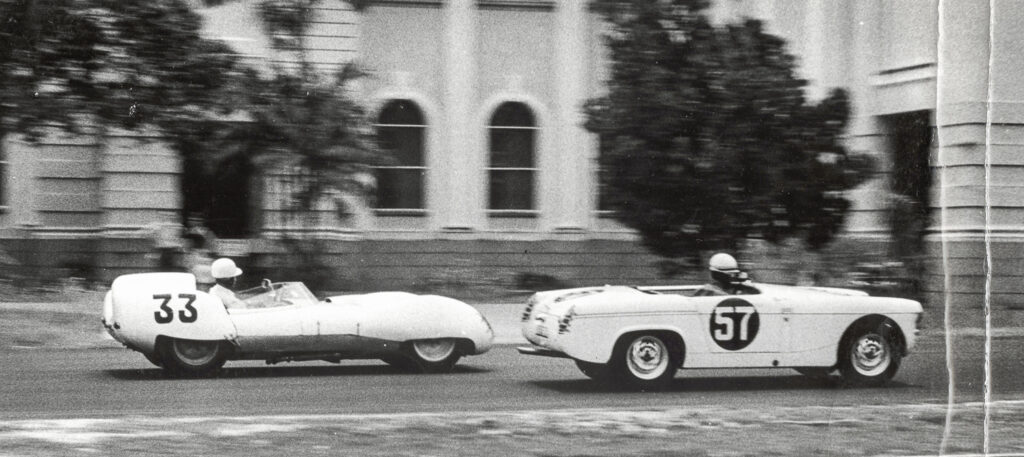
A.A. Aziz’s 948cc MG Midget is about to be lapped by Saw Kim Thiat in his very fast Lotus 15 Climax in the 1963 Mightyplate Trophy support race for sports cars. Saw finished first overall with Aziz fourth overall and first in the sub-1,000cc race.
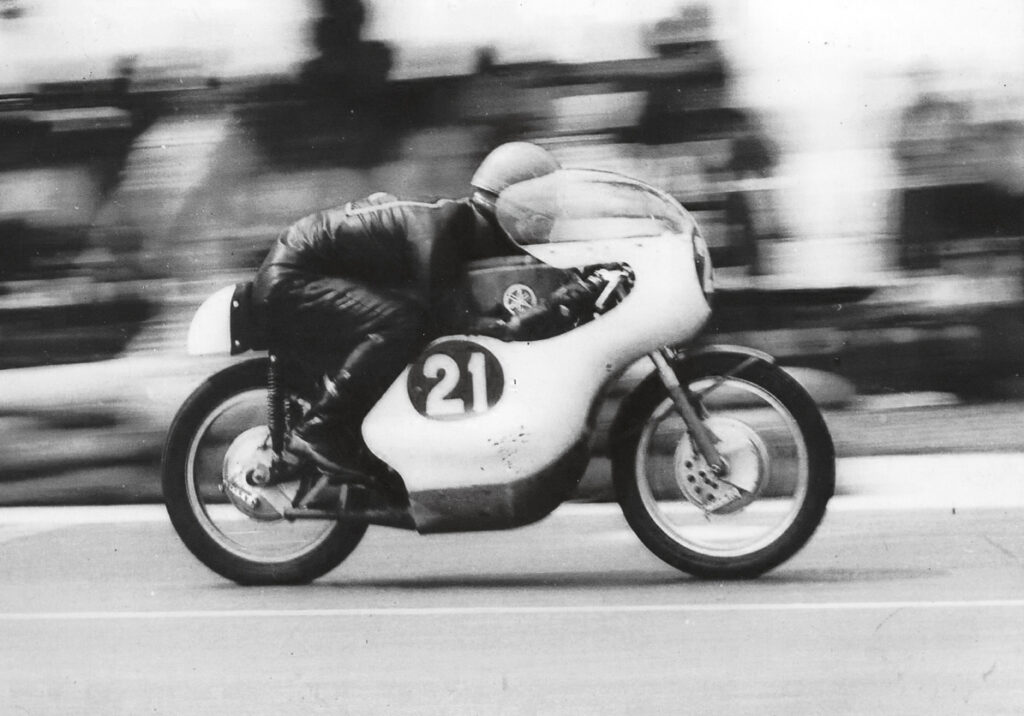
Japanese Yamaha works rider Fumio Ito was one of the favourites to win the 1963 Johore Grand Prix for motorcycles. He did not disappoint with Yamaha’s new RD56 bike.
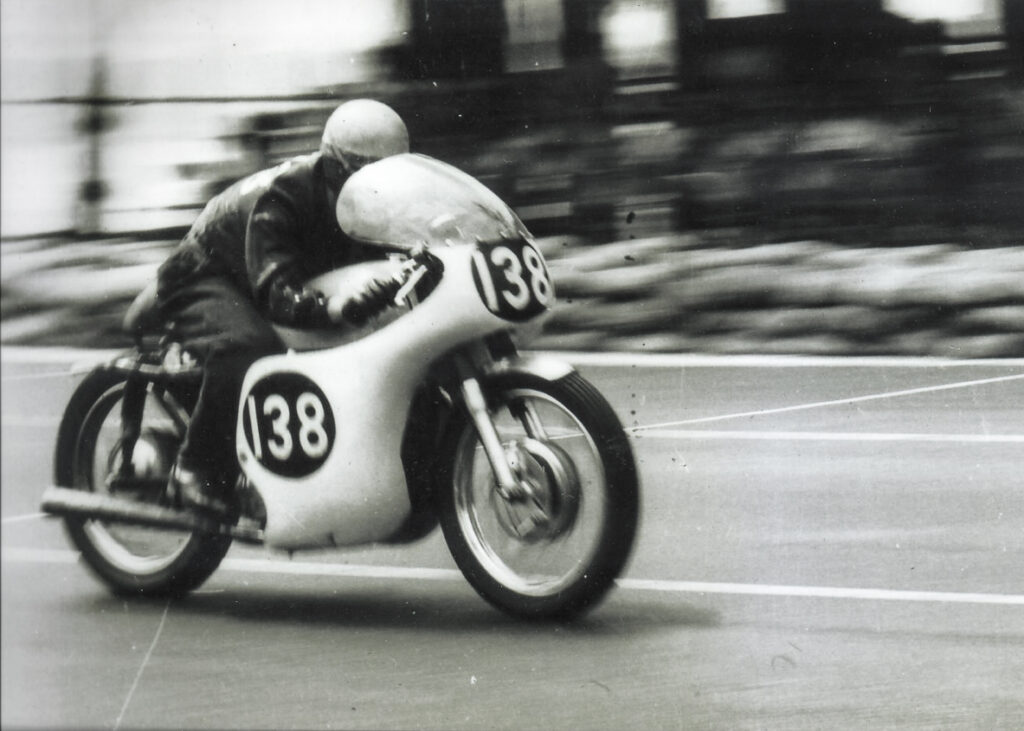
One of the local favourites was Allan Gardiner, seen here at speed in his Norton Manx.
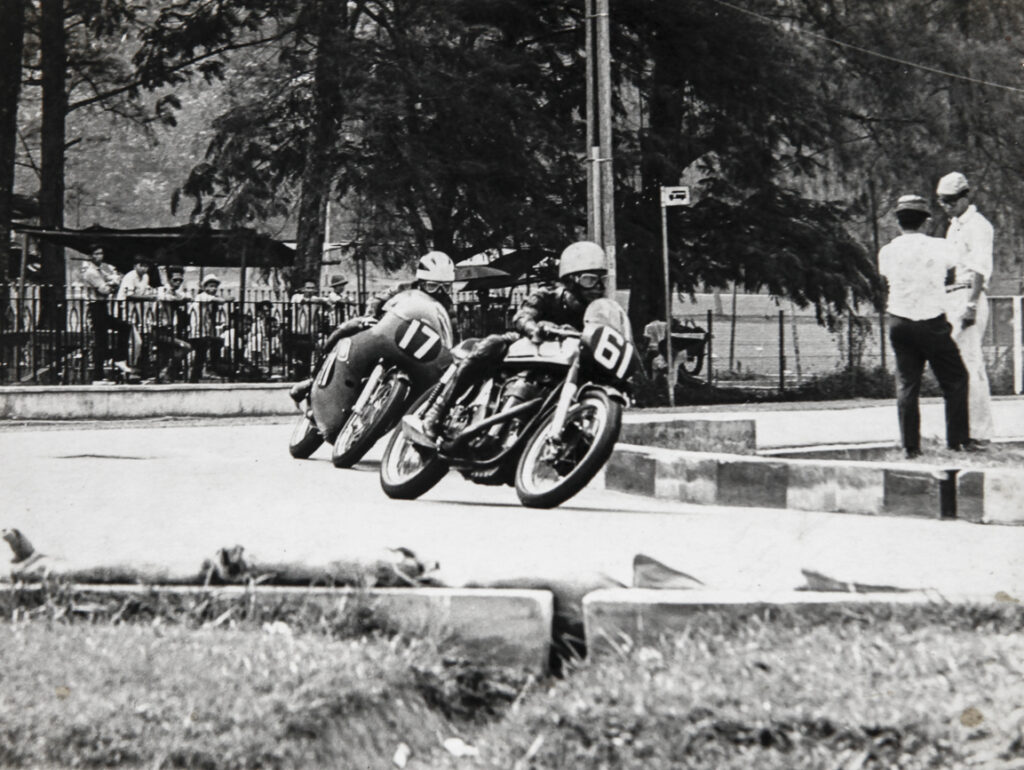
Penangites racing in Johore in 1963 – Bulldog Kuan (Norton) leads Chris Howell (Norton).
For the Grand Prix for racing cars, Singaporean racer Yong Nam Kee, winner of the 1962 Grand Prix in Singapore in a Jaguar E-Type Roadster, had a new import, a Jaguar D-Type, handled by local Jaguar agents Cycle & Carriage20. Albert Poon had his successful Lotus 2321, and there were a number of new cars with entrants keen to make an impression. Singapore’s Rodney Seow had just purchased Stanley Leong’s Lotus 15, the infamous Ferratus that was fitted with a Ferrari 4-cylinder 2-litre engine22. This was to be his first-ever experience with what was deemed a proper race car, and he modestly admitted he “knew nothing about cars.” Sadly, the Ferratus Mk2 was doomed to failure. The pundits knew the race would be a two-way fight between the Jaguar D-Type and the Lotus 23. What they had not realised was that the local mechanics did not understand how complex the Jaguar really was and what was required to set up a real sports racing car with all-wheel disk brakes.
The pundits knew the race would be a two-way fight between the Jaguar D-Type and the Lotus 23.
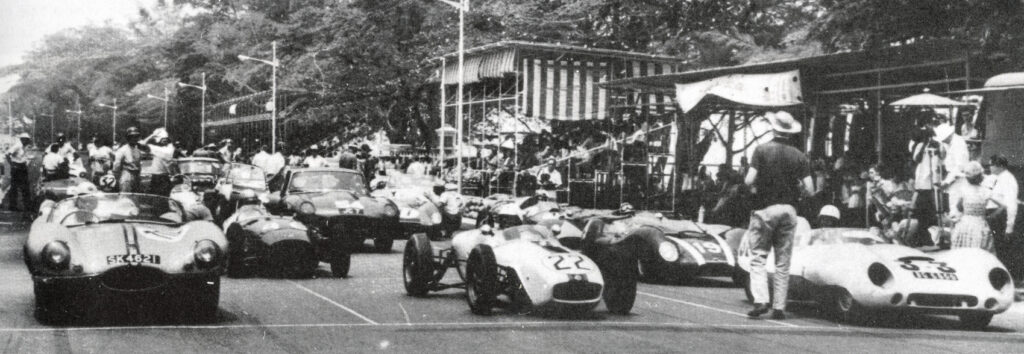
D-Type with John Kirk alongside in the Lotus 18 and Saw Kim Thiat on the far right in the Lotus 15 Climax. Chan Lye Choon is on row two in his #19 Lola Mk1 Climax (favoured over his Lotus 20B).
FATAL CRASH IN JOHORE
The Grand Prix began with Yong surging into the lead with two Hong Kong entrants, Albert Poon and John Kirk, both in Lotus, fast on his tail. Poon took the lead on lap 11, and by lap 36, had built up a 28-second cushion over Yong, lapping everyone but Yong. But victory was marred two laps from the end.
The Johore Grand Prix of 1963 would be best remembered by the shocking death of Yong Nam Kee in a horrific crash on lap 58 of the 60-lap race. Yong, 30 seconds behind Poon on lap 58, was lapping an Austin Healey 3000 when he lost control along the shoreline, hit a lamppost and crashed into a tree. Yong landed on the beach and was pinned under the Jaguar’s heavy motor.
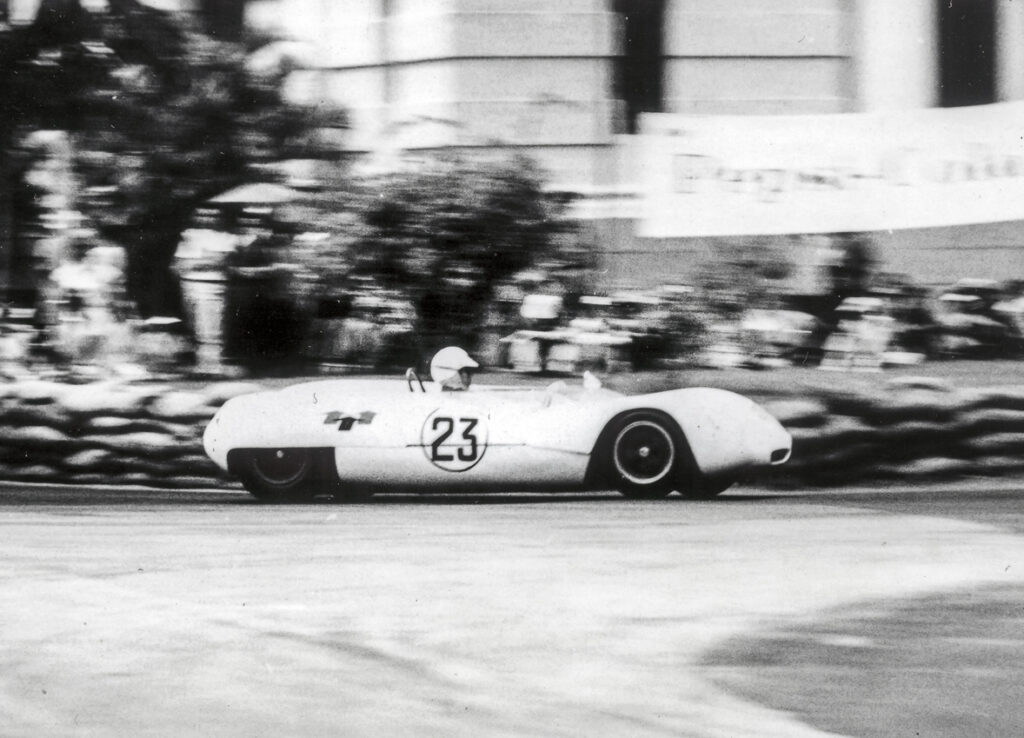
Albert Poon and his Lotus 23 on the way to winning his first Grand Prix – the 1963 Johore Grand Prix. That made it two Grand Prix wins on the trot for then Police Inspector Albert Poon.23
It was a devastating accident but the race continued. At the end, Lotus race cars filled three of the top five positions, and in the drama of the accident, no one realised that in third was Peter Cowling masquerading as Mike J. Cook in the latter’s T51 Cooper Climax24.
Speculation raged over the possible causes of the crash at Zoo Corner on the 58th lap when Yong was in second place and running 30 seconds behind leader and eventual winner Albert Poon.
One theory advanced was that the powerful D-type Jaguar he was driving was not fitted with special racing tyres; the other was that his brakes had not been set up properly. New racing tyres had not arrived in time for the race and Yong was said to have told friends before the race that this was his “only worry.”
A further theory advanced was that Yong apparently suffered from diabetes. When a medical was conducted on him earlier, he got his friends to do the sampling on his behalf. The accident could also have been caused by a number of other factors, including a couple of cars he had been lapping at the time of the crash, Bruce MacRae-Smith’s #51 Austin Healey 3000 and Peter Laws’ #41 Cooper JAP.
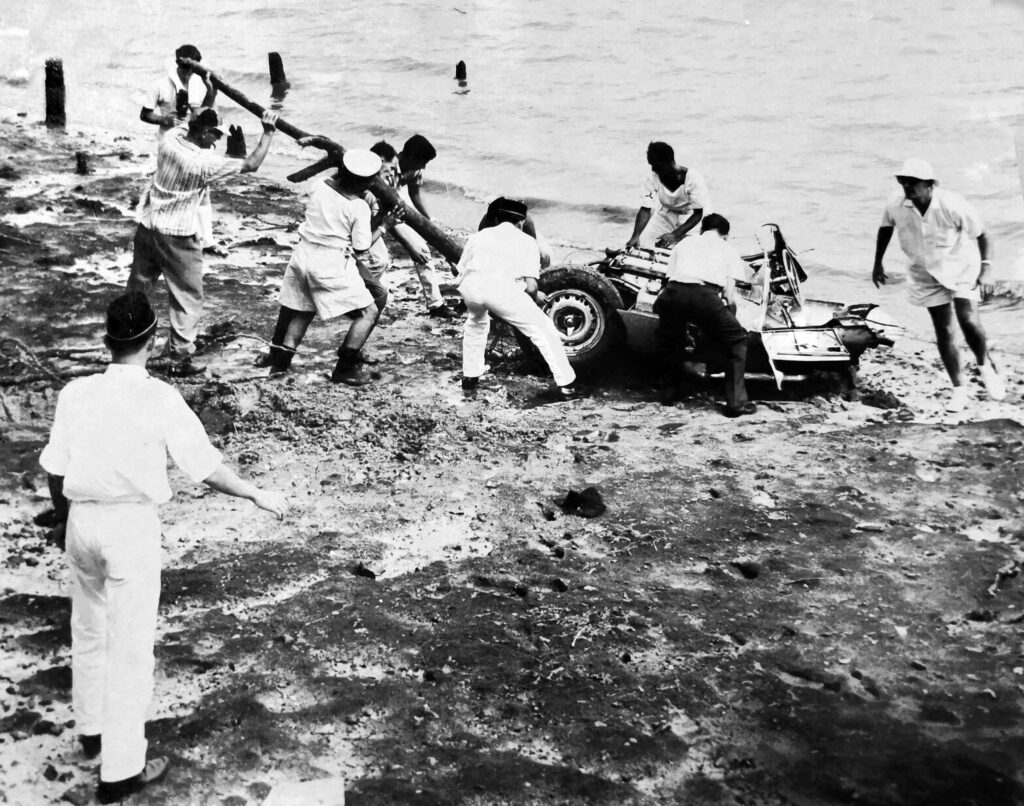
The trauma of Yong’s death in the D-Type cast a shadow on the sport in Asia for a very long time. Some of his friends swore they would never race again.
FAILED PLANS
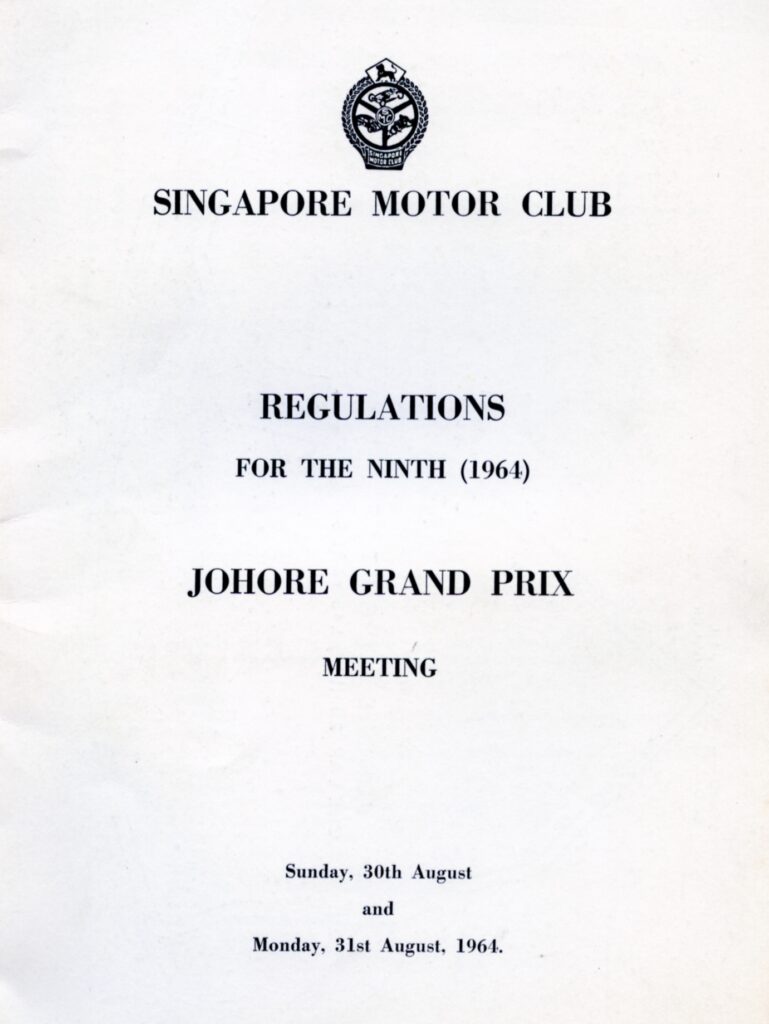
As can be seen, preparations were well in progress for the 1964 Johore Grand Prix before it was cancelled. The Grand Prix race program had yet to be printed when the event was called off but the regulations booklet and entry forms had already been sent off to participants.
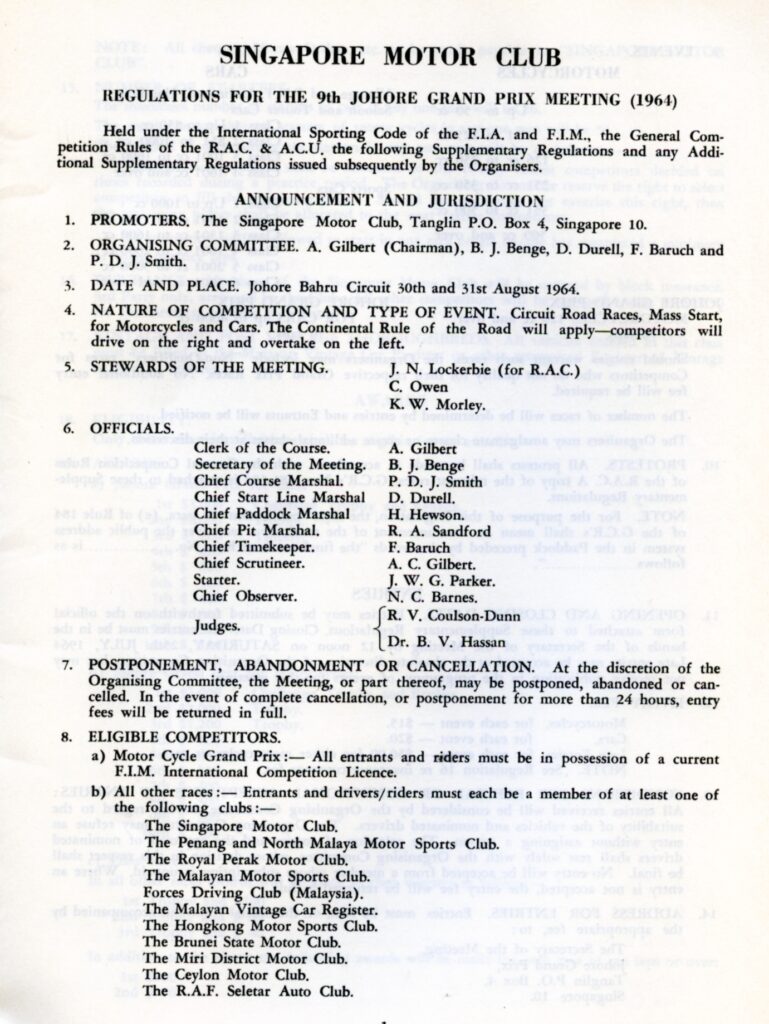
The 1964 Regulations booklet listed the Officials for the Grand Prix. Jimmy Lockerbie25. C. Owen and Kevin Morley were to be the Stewards of the Meeting. Alan Gilbert26 was to be Clerk of Course and Chief Scrutineer and schoolmaster Francis Baruch, future President of the Singapore Motor Club (1966-1968) was to be Chief Timekeeper.
So what exactly happened that caused the cancellation of the Grand Prix in 1964? Was it the Indonesian Konfrontasi that swayed the decision of the organisers, or was it Yong’s horrific death in the 1963 Grand Prix that was the final straw? Whatever the case, there would not be another Johore Grand Prix…not until 1967.
Leave a comment to this post if you would like to see the full set of results (including support races) for the 1960, 1961 and 1963 Grand Prix.
Words by Eli Solomon
NEXT UP – The JOHORE GRAND PRIX – Part 3: 1967-1968
PREVIOUS ARTICLE – THE JOHORE GRAND PRIX – Part 1: 1949-1953
PREQUEL TO PART 1 – GENESIS AND THE WINDS OF WAR
Footnotes
- See LANDING AT CHANGI 1957
- See FOR THE PRICE OF A HOUSE
- See JUST THE RIGHT AMOUNT OF TORQUE
- See JUNGLE WARRIOR
- See JOHORE GRAND PRIX – Part 1: 1949-1953
- The Diamond Jubilee Hall was officially opened by the Regent of Johore on 4 July 1958. The Town Hall was built to commemorate the Diamond Jubilee of the Sultan of Johore in September 1955.
- See MONSTERS & MAVERICKS – the Post-War Malayan Specials
- ON THE STROKE OF TWO
- Knight was Singapore Telephone Board’s General Manager in 1960. He had moved to Singapore on 10 October 1957 as STB’s GM. The new Telephone House had been opened on Hill Street and the island had 60,000 telephones in operation with an estimated 500,000 calls put through every day. Singapore had one telephone for every 28 people. Knight stayed on until March 1962, a 53-month term of secondment from the British General Post Office. He had already been involved on a special assignment as Adviser to the Singapore Government’s proposed takeover of the Oriental Telephone & Electric Company’s assets (taken over on 1 January 1955). Prior to his appointment at STB in Singapore, Knight was assistant to the Engineer-in-Chief of the GPO in London.
- See BAMBOO & BUCKLER for the history of the Wyllie Mistral Special
- For the history of this Aston Martin DB3S, see FOR THE PRICE OF A HOUSE by the same author.
- Ibid.
- See ON THE STROKE OF TWO
- See BAMBOO & BUCKLER
- He arrived in Singapore late in 1959 as an aircraft technician at RAF Seletar and when he headed back home to Warwickshire in February 1962, Christopher Proffitt-White, or Prof as he was affectionately referred to, was a motor racing legend in South East Asia, the only man to have taken the game to the kamikaze Japanese riders in a works Honda Four against their own machines.
- See COOPERHOLIC COUP
- See TROPICAL LOLAS
- See MONSTERS & MAVERICKS – The Post-War Malayan Special
- See THE CASE BOOK OF 23s
- See FROM A FEDERAL STORE – The Cycle & Carriage History
- See THE CASE BOOK OF LOTUS 23s
- The following articles feature the Ferratus’ history: LUNCH WITH CHAMPIONS – RODNEY SEOW; MONSTERS & MAVERICKS; JUNGLE WARRIOR; and 60 YEARS AGO – THE ORIENT YEAR GRAND PRIX
- See THE CASE BOOK OF LOTUS 23s
- See COOPERHOLIC COUP
- Jimmy Lockerbie (Sir James Nisbet Lockerbie, OBE, F.R.I.B.A.) was 54 in 1964. He came to Singapore in July 1950, attached to the Public Utilities Board. He later rose to become City Architect to the PUB in Singapore.
- Alan Gilbert worked for the Singapore Public Utilities Board Electricity Department.. He was President of the Singapore Motor Club in 1958. He was on the 1956 committee when Neil Moncrieff was President. He was Vice President in 1962 and 1964 and continued to play a role in club activities for many years.

